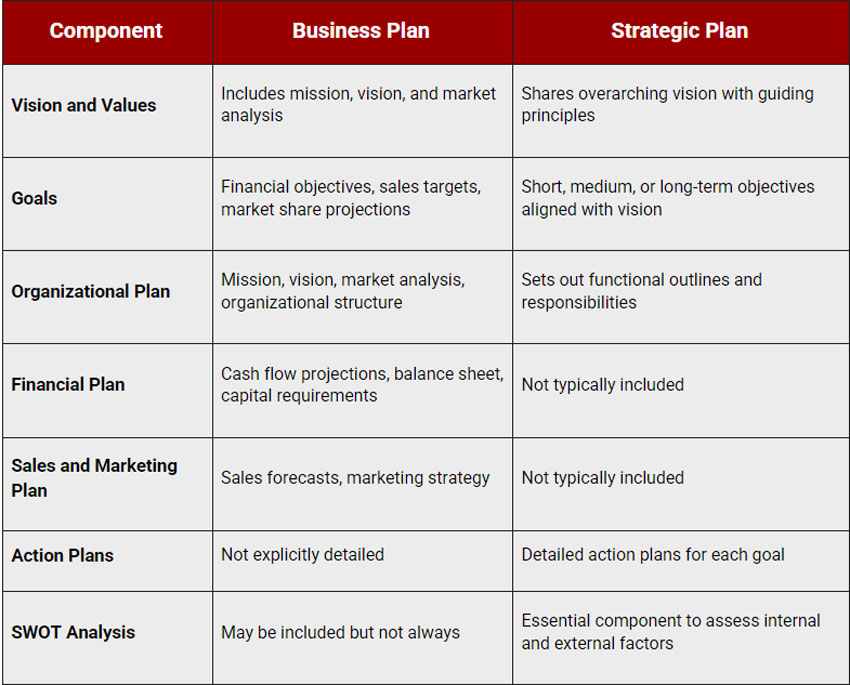

Comparing Business Planning and Corporate Planning
The differences between business planning and corporate planning.
Both business planning and corporate planning involve defining goals for your business and creating plans to support those goals. While they may seem similar at first, each one is used for a specific purpose. It can help to think of business planning as the “what” of your business goals, while corporate planning is the “how”. Learn more about the purpose of each one below.
Business Planning: The “what”
Business planning is the “what” of your business. Your business plan should answer questions about what your business is now and where you see it going in the future.
Business planning involves creating preliminary documents, goals, and plans for your business. This may be necessary when you first have the idea for a business or when you’re changing or adding something to the core of your business. Before you can start getting into the specifics of corporate planning, you’ll need to create a more generalized business plan.
Your company’s business plan should include your company mission and your company strengths and weaknesses. You’ll want to define your short-term and long-term goals regarding growth, finances, and more.
Corporate Planning: The “how”
Successful corporate planning involves creating strategies to help you achieve those business goals you’ve defined in your business plan. Specifically, how are you going to support your company’s mission, and what steps will you and your employees need to take to reach those goals?
To get started in the corporate planning process, you’ll want to take a look into your company’s mission, strengths, and weaknesses. Gather any relevant information on your business’s finances and operations. Relevant documents may include cash-flow statements, credit reports, P&L statements, and up-to-date records of business transactions .
Once you’ve gathered all of the necessary information, you can set specific, measurable goals as part of your corporate plan. These may be goals regarding expansion, sales, employee performance, and more. Here are some sample goals to give you an idea of what to include in your corporate planning strategies:
Increase sales on x product by 30% during the fall quarter
Add 3 employees to x department in the next two months
Increase followers on social media by 100
Once your specific goals are defined, then you can devise specific strategies to help you reach those goals.
Business Planning or Corporate Planning: Which Do I Need?
Both business planning and corporate planning are essential to setting goals and achieving them. No matter the size of your business, these plans and strategies can serve as the framework for your business’s future. As your business grows and your goals evolve, you’ll also want to review your corporate plans to be sure they are aligned with your goals.
Our attorney and dedicated team can help you develop goals and strategic plans for your business through corporate planning. We’ll help you avoid any legal troubles while creating a plan for achieving your business goals. Our team is well versed in corporate law, and we would love to offer you our expertise. Click below for a free consultation to learn more about what we can do for your business.

Business Plan Development
Masterplans experts will help you create business plans for investor funding, bank/SBA lending and strategic direction
Investor Materials
A professionally designed pitch deck, lean plan, and cash burn overview will assist you in securing Pre-Seed and Seed Round funding
Immigration Business Plans
A USCIS-compliant business plan serves as the foundation for your E-2, L-1A, EB-5 or E-2 visa application
Customized consulting tailored to your startup's unique challenges and goals
Our team-based approach supports your project with personal communication and technical expertise.
Pricing that is competitive and scalable for early-stage business services regardless of industry or stage.
Client testimonials from just a few of the 18,000+ entrepreneurs we've worked with over the last 20 years
Free tools, research, and templates to help with business plans & pitch decks
Understanding The Distinction Between a Business Plan & Business Planning
In the dynamic world of entrepreneurship, our choice of words matters. Our vocabulary can often become a veritable alphabet soup of jargon, acronyms, and those buzzwords (I'm looking at you, "disrupt").
And let's not get started on business cliches – "circle back," "synergy," “deep-dive,” etc.
Yet sometimes, it's worth pausing to consider the words we casually sprinkle around in our business conversations. In a previous article, we explored the differences between strategic and tactical business planning , two related but distinct approaches to guiding a business. Now, we're going to delve into another pair of terms that often get used interchangeably but have unique implications: "business plan" (the noun) and "business planning" (the verb).
The business plan, a noun, is a tactical document. It's typically created for a specific purpose, such as securing a Small Business Administration (SBA) loan . Think of it as a road map – it outlines the route and the destination (in this case, the coveted bank loan). But once you've reached your tactical goal (in this case, getting the loan), it often gets shoved in the glove compartment, forgotten as part of the organization's action plan until the next road trip (i.e., additional funding ).
Business planning is not a static concept, but rather a dynamic verb. It's an ongoing process that necessitates continual adjustments. It's about creating a holistic, interconnected value-creating strategic plan that benefits all stakeholders. This includes attracting top-tier employees, ensuring a return on lending or investment, and making a positive impact on the community, whether online or in real life.
That being said, the customer remains at the heart of this process. Without customers, there are no sales, no revenue, and no value. Everything else is contingent on this key element.
If we were to compare the business plan to a map, then business planning would be the journey. It's a continuous process of making strategic decisions, adapting to new paths, and steering the business towards its goals. Sometimes, it even involves redefining objectives midway.
So, let's do a "deep-dive" (I couldn't resist) into these two terms, examining their application in the real world. Along the way, we'll uncover some tools that can aid us in the ever-evolving process of strategic business planning and the more finite task of crafting a winning business plan.
The Business Plan is a Document
Alright, let's take a closer look at a phrase we've all tossed around: the business plan. Imagine it as the detailed blueprint of your organization's goals, strategies, and tactics. It's like the North Star for your entrepreneurial ship, shedding light on the key questions: what, why, how, and when (speaking of questions, here are some FAQs about the business plan ).
Writing a solid business plan isn't easy , especially if you're just dipping your toes into the world of business planning. But don’t worry; we'll get to that (eventually).
So, let's break it down. What does a business plan document consist of, exactly?
- Executive Summary: Just as it sounds, this is a quick overview of the nitty-gritty that's in the rest of your business plan. It's the introduction to your organization, highlighting your mission statement and serving up the essential details like ownership, location, and structure.
- Company Overview: This is where you will detail your products and/or services, their pricing, and the operational plan. If you're opening a restaurant, this section is where you present your menu, and it's also where you talk about your ingredient sourcing, the type of service you'll provide, and the ambiance you're aiming for.
- Market Analysis Summary: This section demands a comprehensive analysis of your industry, target market, competitors, and your unique selling proposition. Without access to top-notch (and often not free) research tools, it can be challenging to find current industry data. Check out our guide on the best market research tools to get started.
- Strategy and Implementation Summary: Here, you'll lay out your short-term and long-term objectives along with the strategies you'll implement to attract and retain customers. This is where you’ll talk about all the different marketing and sales strategies you'll use to charm your future customers.
- Management Summary: This is your chance to spotlight your company's key personnel. Detail the profiles of your key leaders, their roles, and why they're perfect for it. Don't shy away from acknowledging talent gaps that need to be filled, and do share how you plan to fill them!
- Pro Forma Financials: This is where you get down to the dollars and cents with a detailed five-year revenue forecast along with crucial financial statements like the balance sheet and the profit & loss statement.
A business plan is an essential instrument, not just for securing funding, but also for communicating long-term goals and objectives to key stakeholders. But, while a business plan is essential for many circumstances, it's important to understand its scope and limitations. It's a tactical tool, an important one, but it's not the be-all and end-all of business strategy. Which brings us to our next point of discussion: business planning.
Business Planning is a Process
If we view the business plan as a blueprint, then business planning is the architect. But let's be clear: we're not building just any old house here. We're building the Winchester Mystery House of business. Just as the infamous Winchester House was constantly under construction , with new rooms being added and old ones revamped, so too is your business in a state of perpetual evolution. It's a dynamic, ongoing process, not a one-and-done event.
In the realm of business planning, we're always adding 'rooms' and 'corridors' – new products, services, and market strategies – to our 'house'. And just as Sarah Winchester reputedly consulted spirits in her Séance Room to guide her construction decisions, we consult our customers, market data, and strategic insights to guide our strategy. We're in a constant state of assessing, evolving, executing, and improving.
Business planning touches all corners of your venture. It includes areas such as product development, market research, and strategic management. It's not about predicting the future with absolute certainty – we’re planners, not fortune tellers. It's about setting a course and making calculated decisions, preparing to pivot when circumstances demand it (think global pandemics).
Business planning is not a 'set it and forget it' endeavor. It's akin to being your company's personal fitness coach, nudging it to continually strive for better. Much like physical fitness, if you stop the maintenance, you risk losing your hard-earned progress.
Business Planning Case Study: Solo Stove
Now that summer is here, my Solo Stove stands as a tangible testament to effective business planning.
For those unfamiliar, Solo Stove started with a simple yet innovative product – a smoke-limiting outdoor fire pit that garnered over $1.1 million on Kickstarter in 2016, far exceeding its original objective. Since then, it has expanded its portfolio with products tailored to outdoor enthusiasts. From flame screens and fire tools to color-changing flame additives, each product is designed to fit seamlessly into modern outdoor spaces, exuding a rugged elegance that resonates with their target audience.
This strategic product development, a cornerstone of business planning, has allowed Solo Stove to evolve from a product to a lifestyle brand. By continually listening to their customers, probing their desires and needs, and innovating to meet those needs, they've built a brand that extends beyond the products they sell.
Their strategy also includes a primary "Direct To Consumer" (DTC) revenue model, executed via their e-commerce website. This model, while challenging due to increased customer acquisition costs, offers significant benefits, including higher margins since revenue isn’t split with a retailer or distributor, and direct interaction with the customer.
Through its primary business model, Solo Stove has amassed an email database of over 3.4 million customers . This competitive advantage allows for ongoing evaluation of customer needs, driving product innovation and improvement, and enabling effective marketing that strengthens their mission. The success of this approach is evident in the company's growth: from 2018 to 2020, Solo Stove’s revenue grew from $16 million to $130 million , a 185% CAGR.
While 85% of their revenue comes from online DTC channels, Solo Stove has also enhanced their strategic objectives by partnering with select retailers that align with their reputation, demographic, and commitment to showcasing Solo Brands’ product portfolio and providing superior customer service.
Solo Stove's success underscores how comprehensive business planning fosters regular assessment, constant evolution, and continual improvement. It's more than setting goals – it's about ceaselessly uncovering ways to deliver value to your customers and grow your business.
However, even successful businesses like Solo Stove can explore additional strategic initiatives for growth and diversification, aligning with their strategic direction and operational planning. For instance, a subscription model could provide regular deliveries of products or a service warranty, creating a consistent revenue stream and increasing customer loyalty. Alternatively, a B2B model could involve partnerships with adventure tourism operators, who could purchase Solo Stove products in bulk.
These complementary business models, when integrated into the operational plan, could support the primary DTC model by driving customer acquisition, providing ongoing revenue streams and expanding the customer base. This strategic direction ensures that Solo Stove continues to thrive in a competitive market.
The Interplay between the Business Plan (Noun) and Business Planning (Verb)
In the realm of business strategy, there's an intriguing chicken-and-egg conundrum: which comes first, the business plan or business planning? The answer is both straightforward and complex: they're two sides of the same coin, each indispensable in its own right and yet inextricably linked.
The process of business planning informs and modifies the business plan, just as the business plan provides a strategic foundation for the planning process. This interplay embodies the concept of Model-Based Planning™, where the business model serves as a guide, yet remains flexible to the insights and adaptations borne out of proactive business planning.
Let's revisit the Solo Stove story to elucidate this concept. Their business model, primarily direct-to-consumer, laid the groundwork for their strategy. Yet, it was through continuous business planning – the assessment of customer feedback, market trends, and sales performance – that they were able to refine their model, expand their product portfolio, and enhance their growth objectives. Their business plan wasn't a static document but a living entity, evolving through the insights gleaned from ongoing business planning.
So, how can you harness the power of both the tactical business plan and strategic business planning in your organization? Here are a few guiding principles:
- Embrace Model-Based Planning™: Start with a robust business model that outlines your strategic plan. But remember, this isn't set in stone—it's a guiding framework that will evolve over time as you gain insights from your strategic planning process.
- Make business planning a routine: Regularly review and update your business plan based on your findings from market research, customer feedback, and internal assessments. Use it as a living document that grows and adapts with your business.
- Foster open communication: Keep all stakeholders informed about updates to your business plan and the insights that informed these changes. This promotes alignment and ensures everyone is working towards the same goals.
- Be agile and adaptable: A key part of business planning is being ready to pivot when necessary . Whether it's a global pandemic or a shift in consumer preferences, your ability to respond swiftly and strategically to changing circumstances is crucial for long-term success.
Fanning the Flames: From Planning to Plan
The sparks truly ignite when you understand the symbiotic relationship between tactical business plans, strategic business planning, and the achievement of strategic goals. Crafting a tactical business plan (the noun) requires initial planning (the verb), but then you need to embark on continuous strategic planning (the verb) to review, refine, and realign your strategic business plan (the noun). It's a rhythm of planning, execution, review, and adjustment, all guided by key performance indicators.
Business planning, therefore, isn't a one-off event, but rather an active, ongoing process. A business plan needs constant nurturing and adjustment to stay relevant and guide your organization's path to success. This understanding frames your business plan not as a static document, but as a living, breathing entity, evolving with each step your business takes and each shift in the business landscape. It's a strategic roadmap, continually updated to reflect your organization's objectives and the ever-changing business environment.

How to Write a Management Summary for Your Business Plan
Entrepreneurs are often celebrated for their uncanny ability to understand others – their customers, the market, and the ever-evolving global...

Understanding Venture Debt vs Venture Capital
Despite growth in sectors like artificial intelligence, venture capital funding has seen better days. After peaking at $347.5 billion in 2021, there...

Going Beyond Writing: The Multifaceted Role of Business Plan Consultants
Most people think of a professional business plan company primarily as a "business plan writer." However, here at Masterplans, we choose to approach...

Corporate Planning
Corporate planning is crucial to any professional’s or business’s success as it sets a vision for daily operations. With corporate planning, businesses prepare a detailed road map for all their activities. By understanding corporate planning, you can effectively lead and manage a business. This article delves into the nitty-gritty of corporate strategic planning, its varying types, and the stages involved in creating a comprehensive corporate plan.
Defining Corporate Planning
Corporate planning is a detail-oriented process aimed at helping businesses craft solid strategies to achieve their goals. Companies can thrive by mapping out a clear direction, making informed decisions, identifying obstacles, and efficiently allocating resources to support business activities.
The corporate planning process also helps align teams with a shared mission and overcome challenges to achieve established objectives. It is an ongoing, dynamic, and continuous process that continually adapts to shifting business dynamics throughout the lifespan of a company.
Advantages and Disadvantages
Corporate planning consists of extensive future-oriented preparations that provide businesses with a better approach to handling various situations.
However, like everything, there are advantages and disadvantages to the continuous corporate planning process that need to be considered. Below, let’s explore the advantages and disadvantages of corporate planning in detail:
Advantages:
Reduces Uncertainty: Running a business comes with constant uncertainties and risks . An excellent corporate plan goes beyond merely setting objectives. It helps the company by forecasting the value of risks in the future, thereby minimizing the risk of uncertainty and unplanned contingencies.
Unity: Corporate planning helps the employees understand their roles more explicitly. Employees who know what’s expected of them are less likely to engage in conflicts, leading to higher levels of unity within the organization.
Aids Growth: With employee cooperation and constant development of processes within the company’s scope, corporate strategy, and plan objectives are easier to implement, resulting in a higher success rate.

Disadvantages:
Rigidity: Following a strict set of rules as part of a plan can create an inflexible environment that can lower employees’ morale, which can ultimately interfere with productivity.
Time: Corporate planning can take quite some time before the company begins to see results. The process involves collecting data, devising a plan, implementing, monitoring, and evaluating.
Ambiguity: Although corporate planning provides a reference point for business decisions, it is based on predictions of a mutable future. As a result, the plan may only sometimes be foolproof, and unexpected situations can occur, leaving businesses caught off-guard.
The Different Types of Corporate Planning
Corporate planning is a vital aspect of any business, and it involves a variety of planning types, including:
Strategic Planning:
Strategic planning is a crucial process that requires closely examining a company’s missions, strengths, and weaknesses. Its goal is to define the company’s current status, determine where it wants to go, and how it can get there. Although strategic planning and corporate planning share some overlapping areas, corporate planning has a broader scope.
It is particularly useful in functional planning and guiding complex organizations with various subsidiaries and businesses. The corporate plan also includes the same critical components as the strategic plan, focusing on the broader company and any related services used by the departments, such as marketing and human resources. Corporate planning also considers tools for achieving individual business steps such as countering challenges, employee training, and objectives.
Tactical Planning:
Tactical planning is the subsequent step businesses take after formulating a strategic plan. Tactical planning involves defining goals and determining the necessary steps and actions required to achieve them. With it, you can subdivide the strategic plan into smaller objectives and goals. It is a short-term planning process and strategy that can aid in working towards medium or long-term goals.
Operational Planning:
Operational planning is a specific, detailed plan that outlines the business activities’ day-to-day workings for a specific period, generally lasting more than a year. It specifies employees’ and managers’ daily responsibilities and tasks and the workflow. Operational planning is useful in allocating the available financial, physical, and human resources to reach short-term strategic objectives that support an organization’s growth.
Contingency Planning:
Contingency planning is the process of developing strategies that help businesses respond effectively to unexpected disruptive events. It is intended to ensure that the practices return to standard operating procedures after a disturbance or natural disaster. Contingency planning is an effective tool for handling both adverse and positive events, such as an unexpected financial boost that can impact the organization’s operations.
By incorporating these types of business planning, businesses can ensure success in the short term and achieve long-term growth.
Examples of Corporate Planning :
Audacity Corporation, a renowned studio, and live performance microphones manufacturer, wanted to ensure that their range of microphones for streamers and gamers were market leaders by the end of the financial year.
Their CEO, Brendon, decided to study their competitors’ practices and strategies to achieve this target. They discovered that most of their competitors produced these microphones in-house, and their costs of raw materials were high.
To counter this, Audacity collaborated with companies in China and Taiwan to obtain raw materials at reduced prices and trained their employees to assemble the products more efficiently. As a result, their streaming and gaming microphones became the top-selling product in the market, with 20% more sales than their nearest competitor.
ExxonMobil, one of the largest oil and gas companies operating internationally, announced its corporate plans in 2022. One of their declarations was the plan to increase investments in emission reduction solutions.
They have decided to invest $17 billion by 2027 in this domain to achieve this objective. This investment will enable them to gain a competitive advantage over their contemporaries in the market and help them tackle climate change and carbon emissions in the long run.
The Benefits of Corporate Planning
Providing clear objectives.
Not only does corporate planning provide a sense of direction for professionals within an organization and corporate management, but it also ensures that every action taken has a purpose. Executing tasks with a clear plan can help achieve business objectives efficiently.
Formulating Better Strategies
In the context of business, a strategy is an approach taken to achieve a specific goal or objective. For example, if the objective is to make a product the category leader in sales revenue by the year 2023, a potential strategy could be to persuade buyers that the product is superior to other options on the market by investing in large advertising campaigns. Corporate planning is integral to helping an organization create operational plans and execute strategies in a logical and methodical manner, easing the decision-making process.
Increasing Communication
Corporate planning allows group participation in scenario planning, improving communication between employees and employers. Active involvement ensures that tasks are executed efficiently, and everyone remains on the same page.
Allocating Resources Efficiently
In the context of business, a strategy is an approach taken to achieve a specific goal or objective. For example, if the objective is to make a product the category leader in sales revenue by the year 2023, a potential strategy could be to persuade buyers that the product is superior to other options on the market by investing in large advertising campaigns. Corporate planning is integral to helping an organization create and execute strategies in a logical and methodical manner, easing the decision-making process.
Communicating Brand Messaging
A well-defined corporate plan can help communicate a brand’s message to key stakeholders like shareholders, investors, creditors, customers, and employees. By aligning mission and vision statements, core values are clearly established, helping to convey the brand message cohesively.
By implementing corporate planning, organizations can enjoy these benefits and ultimately operate with enhanced efficiency and productivity.

The Six Stages of Corporate Planning
Start with a vision and mission statement.
A vision statement showcases future expectations for a company, such as a goal to offer innovative mobility solutions on a global scale.
On the other hand, a mission statement outlines the organization’s purpose, including target audience, product offerings, and distinguishing factors from competitors. For instance, our company is dedicated to facilitating low-interest healthcare loans to those with poor credit, specifically for low-income households.
Establish Clear-Cut Goals and Objectives
Although people sometimes use the terms interchangeably, goals and objectives have significant distinctions. Fundamentally, a goal defines the aspiration of a company or business over a specific period, while an objective is a measurable and actionable step that propels you toward your goal.
While general goals may suffice for organizations, departments need detailed and specific ones to achieve targets.
For example, a business objective to boost profits would require more specific departmental goals, such as, “We will generate an additional $8,000 in revenue by November 15.” You can create a shared future vision by setting company goals and objectives. This allows everyone to work together towards common goals, making their daily activities more purposeful.
Identify your Organization’s Strengths and Weaknesses
Once you’ve established your business goals and objectives, analyzing the organization’s strengths and weaknesses is a good idea. The most commonly adopted approach for this is the SWOT (Strengths, Weaknesses, Opportunities, and Threats) analysis.
To perform a SWOT analysis, list the characteristics corresponding to each category. Based on this evaluation, you can capitalize on the strengths identified and leverage your opportunities to counter or neutralize the weaknesses and potential threats to the organization.
This kind of analysis will enable you to determine any potential challenges impeding the business goals and help you develop strategies to overcome them. In summary, incorporating a SWOT analysis into your business strategy is an effective way to better understand the organization’s internal and external environment, helping you achieve business growth and success.
Consider Short-term and Long-term Goals
Short-term goals are ones you can achieve in the near future, usually between six months and two years. Long-term goals require more time, usually three to five years. By integrating these two types of goals, you can achieve your goals with ease.
Implement the Plan
After clearly understanding your goals, the next step is to proceed with the plan’s implementation. At this stage, an action plan is usually created with specific responsibilities and an expected timeline for achieving each objective. Regular meetings should be set up to monitor this plan effectively to review progress on the action plans and key performance indicators (KPIs). It’s important to note that during implementation, setbacks or challenges may arise, which is why regular check-ins are necessary. These reviews also allow for recognizing successes and making any necessary corrections.
Evaluate Performance
After implementing all plans, the subsequent critical step involves evaluating their performance. Its purpose is to align your overall expectations with the actual contributions of your plans. Evaluating plan performance is necessary because it helps you measure progress and surface possible areas of weakness. Therefore, to ensure continual improvement towards your goals and maximize impact, evaluating implemented plans’ outcomes is a must.
Corporate Planning Tips :
Share your plan broadly.
For a corporate plan to succeed, the entire company’s involvement is crucial. It’s essential to guarantee that every team member is given access to the business plan and encouraged to participate. Additionally, sharing the plan with board members and department leaders can ensure accountability and commitment and help maintain a clear pathway to achieve the plan’s objectives.
Divide Yearly Plans into Quarters
To simplify a plan, break it down into manageable priorities with deadlines. You can assess the plan’s progress more easily by increasing the frequency of check-ins. If you encounter a challenge, you can make necessary changes to the quarterly plans to keep yourself on track.
Utilize Action Plans
Action plans keep you motivated and on target toward achieving your goals. They help you complete short-term goals in a reasonable amount of time, keeping you moving toward your final objective.
Hold Regular Meetings
Regular check-ins to revise your goals and key performance indicators (KPIs) are crucial. Make necessary adjustments to your corporate plan, find solutions, and achieve your KPIs promptly and efficiently.
To learn more about corporate planning, corporate visions, and more, contact Strategy Capstone !
The magazine of Glion Institute of Higher Education
- Strategic planning vs business planning: how they’re both key to success

Any thriving hospitality business needs thorough planning to make sure it succeeds. If you’ve heard the terms business planning and strategic planning, you might think they’re interchangeable, but they’re actually two distinct things companies need at different times for continued success.
The biggest difference is that business plans are mostly used when you are starting to build a business so you can quickly and smoothly create your vision. Strategic planning is what existing companies use to grow and improve their businesses.
If you’re looking for a career in hospitality management, it’s important to know the difference between the two and how to use them to best effect. In this article, we’ll go over what strategic planning and business planning are and how they are important to running a successful hospitality business.
We’ll also look at how you can learn to harness different planning methods and get the skills needed to develop your career.
Business planning
A business plan is one of the first things a fledgling business will draft. Alternatively, it can be used to set business goals when launching a new product or service.
The business plan will usually look at short-term details and focus on how things should run for around a year or less. This will include looking at concepts such as:
- What the business idea is
- Short-term goals
- Who your customers are
- What your customers need
- What investment or financing you will need to start your business
- How you make revenue
- What profitability to expect
- How you can appeal to potential shareholders
- What the short-term operational needs of the business are
- What the company’s values are
- What the budget is for different parts of the business
This means market analysis and research are vital when you are making a business plan.
What are the objectives of business planning?
The primary objective of a business plan is to have all the main details of your business worked out before you start. This will give you a roadmap to use when you launch your business or when you start offering a different product or service.
For example, if you wanted to become an event planner and open your own event planning business, your plan might include how to get funds to rent an office and pay staff.
Strategic planning

A strategic plan is where you set out the company’s goals and define the steps you will need to take to reach those goals.
A strategic plan would include:
- What current capabilities the company has
- Making measurable goals
- A full strategy for business growth
- How the company’s values, mission and vision tie in with the services and products the company intends to offer
- Who in the organization will handle certain roles
- What the timeline is for reaching certain goals
- A SWOT analysis, looking at the strengths, weaknesses, opportunities and threats in the company
- Examining the external environment for factors that will affect your company using a PEST (political, economic, social and technological) analysis
A strategic plan can be a long-term blueprint. You might find you use basically the same strategic plan for several years.
What is the objective and strategy of planning?
The aim of a strategic plan is to provide a tool that allows you to improve your business, grow the company, streamline processes or make other changes for the health of your business. Strategy implementation and meeting strategic objectives should generally lead to growth.
What is the difference between business planning and strategic planning?
There are a few major differences between strategic planning and business planning, which are outlined below.
Scope and time frame
A strategic plan is usually long-term, typically covering at least two to five years. By contrast, a business plan usually covers a year or less, since this is roughly how long it usually takes for a business to become established.
A business plan focuses on starting a business in its early stages. A strategic plan is used to guide the company through later stages. Put simply, the business plan is about direction and vision, while the strategic plan focuses on operations and specific tactics for business growth.
Stakeholders
A strategic plan will be presented to stakeholders and employees to make sure everyone knows what is going on in the company. This will help reassure everyone with a stake or role in the business.
By comparison, a business plan will often be shown to investors or lenders to help show the business idea is worth funding.
Flexibility and adaptability
A strategic plan typically has more flexibility. This is because it is meant to be in place for a longer period of time and the company should already be established. There is more leeway for refining strategy evolution, while your business plan should remain stable.
Similarities between business planning and strategic planning
Both of these activities will require some of the same analytical components, such as market analysis, financial projections and setting objectives you can track. Of course, both also require you to be highly organized and focused to ensure your business model or strategy development is appropriate for your business.
When to use strategic planning vs business planning

As we’ve already mentioned, you’ll generally use a business plan when you’re setting up a business or moving in a new direction. This will dictate much of the day-to-day running of a business. You would use strategic planning when you want to work on growth and drive innovation.
Can a business plan be used for strategic planning?
No, a business plan and a strategic plan are two different concepts with specific goals. While a business plan outlines short or mid-term goals and steps to achieve them, a strategic plan focuses on a company’s mid to long-term mission and how to accomplish this.
If you want to prepare for success, you need to make sure you are using the right type of plan.
Integrating strategic planning and business planning
While the two plans are different, you may end up using them together to ensure optimal success. As with any type of management role, such as hotel management , strategic and business plan management requires effective communication between different departments.
This includes different strategy managers as well as strategic and operational teams. You also need to make sure that, when you are using either plan, you find the right balance between flexibility and strict adherence to the plan. With strategic planning, this means constant strategy evaluation to assess your tactics and success.
Can strategic planning and business planning be used simultaneously?
In many hospitality careers , you’ll want to juggle growth and new directions, so you could end up using both planning types. However, it’s most common for the two to be distinct. This is because you’ll generally be using a business plan only when you are starting a new venture.
What are the career prospects in strategic and business planning?
There are plenty of options for what you can do if you have skills in strategic planning and business planning. Almost every management role will require these planning skills, including how to write strategic planning documents and measure success.
If you want to work in the hospitality sector, you could look into hotel planning and other careers with a business management degree . These will enable you to grow and nurture a business, but there is also a lot of scope to start your own business. Great planning skills can give you a real competitive advantage.
World-class degrees for making your mark in business
If you want the skills and insider knowledge to guide a business from inception to expansion, our courses provide expert teaching and real-world experience.

What skills do I need for a career in planning?
If you want to work in planning and management, you should work on various skills, such as:
- Decision-making
- Analytical skills
- Risk assessment knowledge
- Market analysis and forecasting
- Team management
- Communication, both written and verbal
- Organization
What qualifications can help with a career in strategic planning or business planning?
If you want to work in hotel planning and management, the most common route is to get a hospitality degree from a well-respected hospitality school in Switzerland . This will help you get the skills and knowledge you need to properly plan businesses as well as handle the execution of these plans.
Business degrees also teach you many transferable skills, such as good communication with your strategy team or data analysis, that you can use in almost any role in hospitality. They can also reduce the need to work your way up through the hospitality industry.
How can hospitality school help with planning careers?
Attending hospitality school can help you learn skills dedicated to hospitality as well as more general management, business and planning skills. This includes everything from how to handle a team to specifics such as hotel revenue management strategies .
If you find a hospitality school offering professional hospitality internships , you’ll also get experience in managing hotels and hospitality venues, helping you leap ahead in your career.
Hospitality degrees to kickstart your career
Our international business course combines leading industry expertise with essential internships to provide an exceptional foundation for a thriving career in the hospitality industry.

Both strategic and business planning are vital to build and grow a business. While business planning focuses on setting up the business and handling investment, vision and overall goals, strategic planning concentrates on growing the business and processing operational efficiency and resource allocation on a longer-term basis.
If you want to learn how to develop a hotel business plan or manage a hospitality venue, one of the best ways to get started is to study for a hospitality degree. This will give you hands-on experience of the strategic planning process or business management as well as the skills you need to succeed.
Photo credits Main image: Westend61/Westend61via Getty Images

LISTENING TO LEADERS

BUSINESS OF LUXURY

HOSPITALITY UNCOVERED

WELCOME TO GLION.
This site uses cookies. Some are used for statistical purposes and others are set up by third party services. By clicking ‘Accept all’, you accept the use of cookies
Privacy Overview
More Like this
What is the difference between a business plan and a strategic plan.
It is not uncommon that the terms ‘strategic plan’ and ‘business plan’ get confused in the business world. While a strategic plan is a type of business plan, there are several important distinctions between the two types that are worth noting. Before beginning your strategic planning process or strategy implementation, look at the article below to learn the key difference between a business vs strategic plan and how each are important to your organization.
Definition of a business plan vs. a strategic plan
A strategic plan is essential for already established organizations looking for a way to manage and implement their strategic direction and future growth. Strategic planning is future-focused and serves as a roadmap to outline where the organization is going over the next 3-5 years (or more) and the steps it will take to get there.
Get the Free Guide for Setting OKRs that Work (with 100 examples!)
A strategic plan serves 6 functions for an organization that is striving to reach the next level of their growth:.
- Defines the purpose of the organization.
- Builds on an organization’s competitive advantages.
- Communicates the strategy to the staff.
- Prioritizes the financial needs of the organization.
- Directs the team to move from plan to action.
- Creates long-term sustainability and growth impact
Alternatively, a business plan is used by new businesses or organizations trying to get off the ground. The fundamentals of a business plan focus on setting the foundation for the business or organization. While it looks towards the future, the focus is set more on the immediate future (>1 year). Some of the functions of a business plan may overlap with a strategic plan. However, the focus and intentions diverge in a few key areas.
A business plan for new businesses, projects, or organizations serves these 5 functions:
- Simplifies or explains the objectives and goals of your organization.
- Coordinates human resource management and determines operational requirements.
- Secures funding for your organization.
- Evaluates potential business prospects.
- Creates a framework for conceptualizing ideas.
In other words, a strategic plan is utilized to direct the momentum and growth of an established company or organization. In contrast, a business plan is meant to set the foundation of a newly (or not quite) developed company by setting up its operational teams, strategizing ways to enter a new market, and obtaining funding.
A strategic plan focuses on long-term growth and the organization’s impact on the market and its customers. Meanwhile, a business plan must focus more on the short-term, day-to-day operational functions. Often, new businesses don’t have the capacity or resources to create a strategic plan, though developing a business plan with strategy elements is never a bad idea.
Business and strategic plans ultimately differ in several key areas–timeframe, target audience, focus, resource allocation, nature, and scalability.
While both a strategic and business plan is forward-facing and focused on future success, a business plan is focused on the more immediate future. A business plan normally looks ahead no further than one year. A business plan is set up to measure success within a 3- to 12-month timeframe and determines what steps a business owner needs to take now to succeed.
A strategic plan generally covers the organizational plan over 3 to 5+ years. It is set with future expansion and development in mind and sets up roadmaps for how the organization will reach its desired future state.
Pro Tip: While a vision statement could benefit a business plan, it is essential to a strategic plan.
Target Audience
A strategic plan is for established companies, businesses, organizations, and owners serious about growing their organizations. A strategic plan communicates the organization’s direction to the staff and stakeholders. The strategic plan is communicated to the essential change makers in the organization who will have a hand in making the progress happen.
A business plan could be for new businesses and entrepreneurs who are start-ups. The target audience for the business plan could also be stakeholders, partners, or investors. However, a business plan generally presents the entrepreneur’s ideas to a bank. It is meant to get the necessary people onboard to obtain the funding needed for the project.
A strategic plan provides focus, direction, and action to move the organization from where they are now to where they want to go. A strategic plan may consist of several months of studies, analyses, and other processes to gauge an organization’s current state. The strategy officers may conduct an internal and external analysis, determine competitive advantages, and create a strategy roadmap. They may take the time to redefine their mission, vision, and values statements.
Alternatively, a business plan provides a structure for ideas to define the business initially. It maps out the more tactical beginning stages of the plan.
Pro Tip: A mission statement is useful for business and strategic plans as it helps further define the enterprise’s value and purpose. If an organization never set its mission statement at the beginning stages of its business plan, it can create one for its strategic plan.
A strategic plan is critical to prioritizing resources (time, money, and people) to grow the revenue and increase the return on investment. The strategic plan may start with reallocating current financial resources already being utilized more strategically.
A business plan will focus on the resources the business still needs to obtain, such as vendors, investors, staff, and funding. A business plan is critical if new companies seek funding from banks or investors. It will add accountability and transparency for the organization and tell the funding channels how they plan to grow their business operations and ROI in the first year of the business.
The scalability of a business plan vs. strategic plan
Another way to grasp the difference is by understanding the difference in ‘scale’ between strategic and business plans. Larger organizations with multiple business units and a wide variety of products frequently start their annual planning process with a corporate-driven strategic plan. It is often followed by departmental and marketing plans that work from the Strategic Plan.
Smaller and start-up companies typically use only a business plan to develop all aspects of operations of the business on paper, obtain funding and then start the business.
Why understanding the differences between a business plan vs a strategic plan matters
It is important to know the key differences between the two terms, despite often being used interchangeably. But here’s a simple final explanation:
A business plan explains how a new business will get off the ground. A strategic plan answers where an established organization is going in the future and how they intend to reach that future state.
A strategic plan also focuses on building a sustainable competitive advantage and is futuristic. A business plan is used to assess the viability of a business opportunity and is more tactical.
10 Comments
I agree with your analysis about small companies, but they should do a strategic plan. Just check out how many of the INC 500 companies have an active strategic planning process and they started small. Its about 78%,
Strategic management is a key role of any organization even if belong to small business. it help in growth and also to steam line your values. im agree with kristin.
I agree with what you said, without strategic planning no organization can survive whether it is big or small. Without a clear strategic plan, it is like walking in the darkness.. Best Regards..
Vision, Mission in Business Plan VS Strategic Plan ?
you made a good analysis on strategic plan and Business plan the difference is quite clear now. But on the other hand, it seems that strategic plan and strategic management are similar which I think not correct. Please can you tell us the difference between these two?. Thanks
Thank you. I get points to work on it
super answer Thanking you
Hi. I went through all the discussions, comments and replies. Thanks! I got a very preliminary idea about functions and necessity of Strategic Planning in Business. But currently I am looking for a brief nice, flowery, juicy definition of “Business Strategic Planning” as a whole, which will give anyone a fun and interesting way to understand. Can anyone help me out please? Awaiting replies…… 🙂
that was easy to understand,
Developing a strategic plan either big or small company or organization mostly can’t achieve its goal. A strategic plan or formulation is the first stage of the strategic management plan, therefore, we should be encouraged to develop a strategic management plan. We can develop the best strategic plan but without a clear plan of implementation and evaluation, it will be difficult to achieve goals.
Comments Cancel
Join 60,000 other leaders engaged in transforming their organizations., subscribe to get the latest agile strategy best practices, free guides, case studies, and videos in your inbox every week..

Leading strategy? Join our FREE community.
Become a member of the chief strategy officer collaborative..

Free monthly sessions and exclusive content.
Do you want to 2x your impact.

- Certifications
- Associate Business Strategy Professional
- Senior Business Strategy Professional
- Examination
- Partnership
- For Academic Affiliation
- For Training Companies
- For Corporates
- Help Center
- Associate Business Strategy Professional (ABSP™)
- Senior Business Strategy Professional (SBSP™)
- Certification Process
- TSI Certification Examination
- Get your Institution TSI Affiliated
- Become a Corporate Education Partner
- Become a Strategy Educator
- Frequently Asked Questions
Business plan vs Strategic Plan - What You Must Know

Like everything else in life, the nature of business needs a plan in place to follow and measure. Crafting a strategic roadmap isn't just a suggestion—it's a necessity.
This is one of the key elements of a startup or even a business division within an organization that is expanding or diversifying. It has every resource element and needs to be mapped out for the business, including projected milestones for the future.
However, every business strategist needs to know that there are some subtle differences between what constitutes a business plan, and the several differences it has with a strategic plan. Let’s walk through the different elements that comprise each and understand the outcome each aims to achieve.
Introducing The Business Plan
A business plan is exactly what the name suggests— a plan to start and run a business or a new entity of an existing business; usually either an expansion in a newer region or a diversification into a new market. Business plans are mainly created for internal reference purposes or external funding purposes, with the latter being the common usage. They form the basis of all business strategies and decisions made at the ownership level in an organization. The most essential components of a business plan include:
Organizational Plan - This is the core of a business plan, and it includes the mission and vision statement, along with the market in which the company plans to operate. This plan also encompasses thorough market research to gauge the potential of the business, crucial for securing funding or sponsorship. It articulates the rationale behind the business's growth trajectory, outlining clear timelines for achieving milestones along the way.
Financial Plan - A robust financial plan is the bedrock of any successful business venture, where cash flow reigns supreme, and a meticulously crafted balance sheet serves as the ultimate scorecard. A financial plan includes some of the most important elements of the entire business plan and includes elements like projected cash flow statements, capital requirements, a summary of projected overheads, a projected balance sheet including assets and liabilities, and income and expense statements.
Remember to regard this as the central nervous system, for it permeates and influences almost every aspiration the enterprise hopes to attain.
Sales and Marketing Plan - We mentioned “almost” everything above for this very reason. Sales and marketing form the other significant component of the business plan. These include sales forecasts and overheads, marketing and brand management summaries, and market share projections that the business hopes to achieve within a time frame.
Business plans are indeed comprehensive and all-encompassing. They form the basis of the business's existence or the rationale for investments in it. But what about translating these plans into action? How do we ensure that the sky-high goals set forth are actually achievable?
The Actionables- A Strategic Plan
Strategic plans constitute the basis of operations and responsibilities within the business. These plans lay the paths out for each member of the organization to follow and define the functional outline and the key outcomes for every project and process within the business. A strategic plan goes on to define the operations and their outcomes within the organization, its departments, and its employees. The single thread connecting strategic planning with the business plan is the vision of the organization, and for obvious reasons— vision serves as the guiding light for strategy formation, which, in turn, directs the day-to-day operations of the business.
Why A Strategic Plan is Crucial to The Organization
In a word— synchronization. A robust and well-laid-out strategic plan establishes the much-needed sync between teams and their objectives. Not only that, it also provides a guide for daily operations alongside the focus and direction that teams often need to get the job done, on time and within budget. When all these components are integrated into a cohesive network, the true value of a strategic plan emerges—a seamless and grand orchestration of departments, teams, and individuals using the resources allocated to them to achieve the key performance indicator that they are responsible for.
Elements to Consider in a Strategic Plan
When tasked with creating a strategic plan for your business, you will need to incorporate certain components that will ensure that the stakeholders are aligned completely with the organization’s goals and objectives. These include:
Vision and Values - The vision statement is the most important component of the strategic plan and the most overarching. It propels the organization towards established goals and the values that every employee and stakeholder must incorporate.
Goals - These are short, medium, or long-term, depending on the scope of the strategic plan. They provide the much-needed context for the organization to undertake initiatives that meet the vision while maintaining the values.
Guiding Principles - Often, organizations face crossroads where they must decide which steps to take next, to reach their vision. Principles are included in strategic plans to align teams towards the vision when faced with a dilemma and form a critical part of strategic planning.
Action Plans - A sum of key initiatives, processes, and projects that are required to be performed on a pre-determined periodic basis for the goal to be accomplished. These also include the time frames for each stakeholder responsible for each option. They usually follow the DACI format for each action (Driver, Approver, Contributor, Informed)
SWOT Analysis - The quintessential component, the Strength, Weaknesses, Opportunities, and Threats analysis of the strategic plan lends context to all business actions vis-a-vis the external environment. This includes competitors, market forces and conditions, identification of internal and external threats, and several other factors.
Read This - SWOT Analysis: How to Strengthen Your Business Plan
Here’s a table highlighting the main differences between a Business Plan and a Strategic Plan with a focus on the key components of each—

Learning All About Strategic Planning
In all businesses, a strategic plan serves as the foundational blueprint, akin to a meticulously drawn map for a general. It provides the essential guidance and direction needed for the entire organization to navigate toward success. It is crucial, therefore, to acquire the necessary skills and certifications for employment as a business strategist who would be entrusted with creating it. Know more about how to become a successful and sought-after business strategist today!

Recent Posts

How Data Analytics Can Revolutionize Your Business - A Strategist's Guide
Download this Strategist's Guide to empower yourself with resourceful insights:
- Roadblocks to Data Usage
- Advantages that Data Analytics offer for businesses
- Elements of a Data Analytics Strategy
- Top reasons why businesses must adopt a Data Analytics Strategy
- Case studies, Scenarios, and more

CredBadge™ is a proprietary, secure, digital badging platform that provides for seamless authentication and verification of credentials across digital media worldwide.
CredBadge™ powered credentials ensure that professionals can showcase and verify their qualifications and credentials across all digital platforms, and at any time, across the planet.

Verify A Credential
Please enter the License Number/Unique Credential Code of the certificant. Results will be displayed if the person holds an active credential from TSI.
Stay Informed!
Keep yourself informed on the latest updates and information about business strategy by subscribing to our newsletter.
Start Your Journey with The Strategy Institute by Creating Your myTSI Account Today.
- Manage your professional profile conveniently.
- Manage your credentials anytime.
- Share your experiences and ideas with The Strategy Institute.
Account Login
- Remember Password
- Forgot Password?
Forgot Password
Our content is reader-supported. Things you buy through links on our site may earn us a commission
Join our newsletter
Never miss out on well-researched articles in your field of interest with our weekly newsletter.
- Project Management
- Starting a business
Get the latest Business News
Business plans vs. strategic plans.

What sets a business plan apart is its singular focus on market and operational feasibility. In contrast, a strategic plan clarifies the long term direction of the organization; most business plans look at a shorter period of time, typically 2-3 years, and drills down thoroughly how the work will get done and dollars will be earned.
Business plans typically take more resources, both internal and often external (in the form of consulting assistance) to develop the kinds of operational and financial analysis necessary to fully test the feasibility of business venture or an organization as a whole.
It gets down to specifics about who the customers will be, what they will pay (with research backing that up), what marketing will be needed to reach them, who the competition will be, and how the finances will work out, in detail.
The feasibility part of the business plans means that it’s entirely possible that the idea you seek to develop is not feasible, at least not with your current set of assumptions.
While strategic plans in theory have that escape clause also, rarely is it used. Finally, a credible business plan has to include who (the skilled managers) who will carry it out. It’s not a business plan if it doesn’t include the people who will implement it.
The above is a graphic from our colleagues at Social Impact Architects laying out some of these differences for the social sector.
- Copyright © 2014 Rolfe Larson Associates
- Social Impact App , find social enterprises nearby and online
- Venture Forth! endorsed by Paul Newman of Newman’s Own

Rolfe Larson

Resources for Starting a Business
Legal Structures of Organizations Legal Forms and Traditional Structures of Organizations Market Research — Inbound Marketing Planning Your Research Market Research Find and Feed the Feeling Strategizing Understanding Strategy and Strategic Thinking Competitor Analysis Porter’s Five Competitive Forces (Part I) Porter’s Five Competitive Forces (Part 2) Competitive Intelligence Product Planning Product Management E-Commerce Sales and …

Ultimate Business Planning Guide with Updated Resources
Complete Business Planning Guide with Extensive Resources Copyright Carter McNamara, MBA, PhD. NOTE: Your business plan should be highly customized to your current organizational situation. Thus, using a generic business plan template could completely misrepresent the needed focus of your business plan. (This step-by-step manual is a complement to the topic How to Start Your …

Learn Strategic Thinking from Napoleon
Biographers of Napoleon Bonaparte talk about his ability to size up a situation with a single coup d’oeil,(pronounced koo-DOY), meaning “a stroke of the eye” or “glance.” Napoleon was so knowledgeable about his strategic situation—the landscape, the enemy, available technology, similar situations from the past—that he could understand and respond quickly to ever- changing circumstances. …

Strategic Planning Facilitator: Guiding the Planning Process
Strategic Planning: The Crucial Role of a Facilitator The goal of strategic planning should be to produce a Plan that is 1) relevant, realistic, and flexible; 2) with a very high likelihood of being implemented; 3) in order to achieve the purpose of the planning, e.g., a purpose to evolve to the next stage of …

Mistakes Made by Strategic Planning Facilitators
Here’s a list of the biggest mistakes that I have seen made by strategic planning facilitators over the years: 1. Not getting sufficiently trained on how to do facilitating, e.g., planning the meeting, goals, ground rules, which techniques to cultivate complete participation, doing interventions, managing conflict 2. Not learning a variety of strategic planning models, …

Strategic Thinking in the Age of LinkedIn
LinkedIn founder and triple billionaire Reid Hoffman has two endearing mannerisms that reveal the way he sees–and reasons with–the strategic environment. First, he peppers his statements with the word so. Almost a verbal tic that would grate on a speaking coach like the overuse of the dreaded uh … but he uses it more like …
Avoid the Silicon Valley Syndrome!
Guest blog from my colleague, Adam Brock, Director of Social Enterprise at Joining Vision and Action (formerly JVA Consulting): How can a well-meaning startup avoid “Silicon Valley Syndrome” and actually use a social startup to create real value for society? Every era has an industry that epitomizes its values. At the turn of the 20th …

Develop Your Strategic Intuition
The best decision-makers in chaotic “fog of war” conditions seem able to call on intuition – knowing what to do without knowing why or how they know.

Free Online Program to Learn Strategic Planning Facilitation

Moneyball: The Role of the Chief Strategy Officer
Paul DePodesta – role of the Chief Strategy Officer for the Cleveland BrownsPaul DePodesta was recently named the Chief Strategy Officer by the Cleveland Browns of the National Football League. This is significant because, as any fan of Moneyball knows, Mr. DePodesta has spent his career in the sport of baseball, not football. This matters …

50 Tips and Tools for Effective Strategic Thinking Skills
To engage in strategic thought, you must think and reflect on the big picture—on the diverse players and forces in your competitive environment. Anticipate the future. Use your right brain for intuition and wisdom, and your left for planning. As Isaac Newton said, “Truth is the offspring of silence and meditation.” Here are 50 tips …

To Learn Strategy, Know History
When you are faced with the most important and strategic decision of your life, where can you go for wisdom? Can you find insight in a book of history? Facing a world in crisis, John F. Kennedy did just that. Generally, we learn skills by trying something, failing, and trying again until we get it …

Execution Trumps Strategy
The results are in – Execution trumps strategy. Your business plan may have great strategies, but it will be a great failure if executed poorly. So just hire the right people, right? Turns out the answer is not what you think. At least according to a recent Harvard Business Review Article. Five Myths About Effective …

Is Balance Possible?
Now here’s a frank perspective: Balance doesn’t work. So don’t even try. Accept the fact that the only way to really make something happen is to go “full out” at it, with everything you have.

B Corp As A Competitive Edge?
Last week, I attended a celebration for B corps in Colorado. These are for-profit companies certified by a nonprofit called B Lab for achieving social and environmental goals along with business ones. What I noticed differently from other discussions among B Corps in the past, was a stronger focus not only on this vibrant community …
Privacy Overview
Business Plan Vs Strategic Plan Vs Operational Plan—Differences Explained

Noah Parsons
5 min. read
Updated October 27, 2023
Many business owners know and understand the value of a business plan. The business plan is a key component of the startup and fundraising process and serves as a foundation for your organization. However, it only tells part of the story. To get the whole picture and have a framework on which to build your business you also need a strategic plan and an operational plan.
- What is a business plan?
In its simplest format, a business plan describes the “who” and the “what” of your business. It lays out who is running the business and what the business does. It describes the products and services that your business sells and who the customers are.
- What is a strategic plan?
A strategic plan looks beyond the basics of a business plan to explain the “how”. It explains the long-term goals of the business and how it expects to achieve those goals over the long term. A strategic plan explores future products and services that your business might offer and target markets that you might expand into. The plan explains your strategy for long-term growth and expansion.
- What is an operational plan?
An operation plan zooms into the details of your business to explain how you are going to achieve your short-term goals . It is the “when” and “where” of your planning process. The operational plan covers the details of marketing campaigns, short-term product development, and more immediate goals and projects that will happen within the next year.
- What is the difference between a strategic plan and a business plan?
First, let’s look at the difference between a business and a strategic plan. For review:
A business plan covers the “who” and “what” of the business. The strategic plan gives us long-term goals and explains “how” the business will get there, providing a long-term view.
In broader terms, the business plan tells us who by showing us:
- Who is running the business? What makes them qualified? What do they bring to the table that adds value?
- Who is the competition? What do they offer and what makes you different?
- Who is your customer? How big is the market? Where are they? What do they want and how will you give it to them? Also, how will you connect with your market?
The business plan answers the “what” by telling us:
- What the business provides and how it’s provided.
- Product, services, and operations are all explained so that readers understand how customer needs are met.
The strategic plan, on the other hand, outlines long term goals and the “how”, focusing on the following:
- Where will the business be in 3, 5, or even 10 years?
- How will you expand to offer different products and services over time?
- Will your market and industry change over time and how will your business react to those changes?
- How will you grow your market and reach new customers?
- What needs to happen so you can achieve your goals? What resources do you need to get there?
- How will you measure success? What metrics matter and how will you track them?
So, your business plan explains what you are doing right now. Your strategic plan explains long-term aspirations and how you plan to transition your business from where it is today to where you want it to be in the future. The strategic plan helps you look more deeply into the future and explains the key moves you have to make to achieve your vision.
Brought to you by
Create a professional business plan
Using ai and step-by-step instructions.
Secure funding
Validate ideas
Build a strategy
- What is the difference between strategic planning and operational planning?
While strategic planning looks at the long term and explains your broad strategies for growth, an operational plan looks at the short term. It explains the details of what your business is going to do and when it’s going to do it over the next twelve months or so. An operational plan covers details like:
- What activities need to happen to achieve your business goals?
- When will each activity take place, who will do it, and when do you need to reach specific milestones?
- How will your business operate? What suppliers will you work with? When do you need to have them in place?
- What marketing campaigns will you run and what will they cost?
- What investments will you make in your products and services this year?
The bottom line, your operational plan is the short-term action plan for your business. It’s the tasks, milestones, and steps needed to drive your business forward. Typically an operational plan provides details for a 1-year period, while a strategic plan looks at a 3-5 year timeline , and sometimes even longer. The operational plan is essentially the roadmap for how you will execute your strategic plan.
- How to use your business plan for strategic development and operations
A great business plan can encompass both the basic plans for the business, the long-term strategic plan, and the near-term operational plan. Using a lean planning method, you can tackle all three phases of planning and make the process easy to review and revise as your business grows, changes, and adapts.
Start with a simple plan
The lean planning methodology starts with a simple, 30-minute business plan that outlines the fundamentals of your business: who you are, what you are doing, and who your customers are. It’s a great way to provide a brief overview of your business.
Expand your plan
From there, you can expand your plan to include your longer-term strategy. Adding greater detail to elements of the plan to explain long-term goals, milestones, and how your products and services will change and expand over time to meet changing market conditions.
Finally, your lean plan will cover financial forecasts that include monthly details about the short-term revenue and expenses, as well as longer-term annual summaries of your financial goals, including profitability and potential future loans and investments.
- Use your business plan to manage your business
Regardless of the type of plan, you are working on, you need a team of players on hand to help you plan, develop, and execute both the operational and strategic plans. Remember, your business needs both to give it a clear foundation and a sense of direction. As well as to assist you with identifying the detailed work that has to happen to help you reach your long-term goals.
Learn how LivePlan can help you develop a business plan that defines your business, outlines strategic steps, and tracks ongoing operations. You can easily share it with your team and all of the right stakeholders, explore scenarios and update your plan based on real-world results. Everything you need to turn your business plan into a tool for growth.
See why 1.2 million entrepreneurs have written their business plans with LivePlan
Noah is the COO at Palo Alto Software, makers of the online business plan app LivePlan. He started his career at Yahoo! and then helped start the user review site Epinions.com. From there he started a software distribution business in the UK before coming to Palo Alto Software to run the marketing and product teams.

Table of Contents
Related Articles

10 Min. Read
Use This Simple Business Plan Outline to Organize Your Plan

14 Reasons Why You Need a Business Plan

7 Min. Read
8 Business Plan Templates You Can Get for Free

6 Min. Read
Business Plan vs Business Model Canvas Explained
The Bplans Newsletter
The Bplans Weekly
Subscribe now for weekly advice and free downloadable resources to help start and grow your business.
We care about your privacy. See our privacy policy .

The quickest way to turn a business idea into a business plan
Fill-in-the-blanks and automatic financials make it easy.
No thanks, I prefer writing 40-page documents.

Discover the world’s #1 plan building software

Excellence in early learning
Small & Medium Business
Be released from the day-to-day
Start-Ups & Software
Find fit & grow your team
Board meetings
Run board meetings with ease.
Plans & roadmaps
Build organization or team plans.
Strategic alignment
Align leaders and teams.
Performance intelligence
AI powered performance intelligence.
Operating efficiency
Simplify, focus, and automate.
Business transformation
Run business improvement programs.
People development
Data driven people development.
Write plans, procedures, notes, or policies.
Use AI to build smart goals & OKRs.
Your vision masterplan.
Run projects, oragnize tasks across teams.
Align the operating rhythm, run effective meetings.
Diagnostics
Find growth gaps across the business.
Build scorecards, visualize performance.
Why partner?
Easier advisory with a demonstrable ROI

Become a partner
Become a fractal Chief of Staff.
ROI Calculator
See the ROI in our program.
GET CERTIFIED
Advisor Certifications
Be recognized as a strategic leader.
Platform specialist
Implement agile leadership practices.
CX Consultant
Lead sales, marketing, & service strategy.
EX Consultant
Lead people & culture strategy.
Business consultant
Lead business planning & strategy.
Leadership coach
Lead executive coaching.
Certified advisor
Fractal Chief of Staff, COO, or Strategic Advisor.
Help centre
Help and knowledge articles.
Waymaker Academy
Grow your skills.
Leadership articles.
Events & webinars
Join a masterclass.
Download resources.
Listen, learn, connect.
Product overview
3 Ways to build a better business.
Diagnose gaps, roadmap, goals & more
Watch a demo
Watch a detailed overview of Waymaker.io
For start ups & small business
Every essential step to grow
For scaling & enterprise business
Release your team to scale your business
For coaches & consultants
Become a high value advisor as a Waymaker partner
Playbooks for growth
On demand playbooks in Waymaker Academy
License types, prices and start a free trial
START MY FREE TRIAL
Lead and deliver
Get certified + free courses & playbooks
Waymaker's Leadership Curve
The framework overview
News & articles
Listen to leaders
eBooks & Webinars
Learn with our eBooks & Webinars
Get started, learn & find help
WATCH A DEMO
Build a better business with Waymaker partnership
How to partner
3 steps to a better coaching & consulting business
Get Certified
Become a Waymaker Certified Advisor
High Growth Advisor Program
Scale your advisory
Grow your partner business
Access free & paid services to grow your business
Model your partner ROI
Use our ROI calculator
SPEAK WITH OUR TEAM
About Waymaker
Join our team?
APPLY FOR A ROLE

Build a scaleable business & leadership advisory business.
Discover Waymaker partnership.
Become a Waymaker Partner
Scale your coaching & consulting.
Free courses and playbooks for Waymaker partners.
Be recognized for leadership.
Platform Specialist
For agile & business coaches.
For sales and marketing consultants.
For HR consultants and coaches.
Business Consultant
For strategic business coaches & consultants.
Leadership Coach
For executive and leadership coaches.
Certified Advisor
For recognized experts in leadership and strategy.

Bite sized brilliance to grow your business.
Leadership Blog
Podcast | leadership torque.
Helping you make business improvement, business as usual.
Learn with our downloadable eBooks.
Merch & Resources to help you achieve more by doing less.
Free courses and playbooks.
Leadership software
What is leadership software?
Waymaker Leadership Curve
A framework overview.
Get started, learn & find the help you need.

Platform features
Waymaker's intelligent platform includes goals (OKRs), roadmaps, meetings, tasks, and dashboards.
Diagnose growth gaps.
Create goals and OKRs.
Create roadmaps of goals.
Tasks, task automation, and task templates.
Automate meetings and minutes.
Build scorecards, view goal and task dashboards.
Professional services
Increase profits, reduce chaos.
Property & Development
Streamline & reduce risk.
Software & Technology
Align everyone, outperform growth
Small business
Work on your business, not in it.
WAYMAKER LEADERSHIP BLOG
- Effective Strategic Plans and Business Plans: Understanding the Difference Between
by Waymaker | Jul 25, 2023
Defining Strategic Plans and Business Plans
What is a strategic plan, what is a business plan, key components of strategic plans and business plans, elements of a strategic plan, elements of a business plan, the purpose and goals of the strategic plan and the business plan, the purpose of a strategic plan, the purpose of a business plan, the planning process: strategic plans vs. business plans, developing a strategic plan, developing a business plan, the role of stakeholders in each plan, stakeholder involvement in strategic plans, stakeholder involvement in business plans.
- You may also like...
Get started
In the world of business, the terms strategic plans and business plans are often used interchangeably. However, there are significant differences between these two types of plans that are important for entrepreneurs and business leaders to understand.

Before delving into the differences between strategic plans and business plans, it’s important to define each term.
A strategic plan is a long-term plan that outlines an organization’s goals and objectives and the actions needed to achieve them. It typically covers a three to five-year time period and focuses on broad, high-level initiatives that will position the organization for success in the future.
Strategic planning is a crucial process for any organization that wants to succeed in today’s competitive business environment. It allows organizations to identify their strengths, weaknesses, opportunities, and threats, and to develop a plan of action that will help them achieve their long-term goals.
During the strategic planning process, organizations typically conduct a thorough analysis of their internal and external environments. This includes an assessment of their current strengths and weaknesses, as well as an analysis of the market, competition, and other external factors that could impact their success.
Based on this analysis, organizations develop a set of strategic objectives and initiatives that will help them achieve their long-term goals. These initiatives may include expanding into new markets, developing new products or services, or investing in new technologies.
A business plan , on the other hand, is a detailed plan that outlines the steps a company will take to achieve its short-term goals and to operate on a daily basis. It typically covers a one to three-year time period and includes detailed financial projections, marketing plans, and operational strategies.
A business plan is a critical tool for any entrepreneur or small business owner who wants to succeed. It allows them to identify their target market, develop a marketing strategy, and create a roadmap for achieving their financial goals.
When developing a business plan, entrepreneurs typically begin by conducting market research to identify their target market and assess the competition. They then develop a marketing strategy that will help them reach their target market and differentiate themselves from the competition.
In addition to marketing, a business plan also includes detailed financial projections that outline the company’s revenue and expenses over the next one to three years. This allows entrepreneurs to identify potential financial challenges and develop strategies to overcome them.
Finally, a business plan includes operational strategies that outline how the company will operate on a day-to-day basis. This includes everything from hiring and training employees to managing inventory and fulfilling orders.
In conclusion, while both strategic plans and business plans are important tools for organizations and entrepreneurs, they serve different purposes. Strategic plans focus on long-term goals and broad initiatives, while business plans focus on short-term goals and daily operations.
Strategic plans and business plans are essential tools for any organization looking to achieve long-term success. While both plans share some common elements, they differ in their focus and level of detail.
A strategic plan is a comprehensive document that outlines an organization’s long-term goals and objectives. Key components of a strategic plan include:
- Mission Statement: This statement defines the organization’s purpose and values, and provides a framework for decision-making.
- Vision Statement: This statement describes the organization’s long-term aspirations and what it hopes to achieve in the future.
- Objectives: These are specific, measurable goals that the organization aims to achieve within a set timeframe.
- Strategies: These are the broad approaches that the organization will take to achieve its objectives.
- Tactics: These are the specific actions that the organization will take to implement its strategies.
By outlining these key components, a strategic plan provides a roadmap for the organization to follow as it works towards its long-term goals.
A business plan is a detailed document that outlines how a company will achieve its short-term and long-term goals. While it shares some elements with a strategic plan, a business plan is more focused on the day-to-day operations of the business. Key components of a business plan include:
- Executive Summary: This is a brief overview of the entire business plan, highlighting the key points and goals.
- Market Analysis: This section provides an in-depth look at the industry and market in which the company operates.
- Marketing and Sales Strategies: These are the specific tactics that the company will use to promote and sell its products or services.
- Operational Plans: This section outlines the day-to-day operations of the business, including staffing, production, and logistics.
- Financial Projections: This section provides detailed financial projections, including revenue, expenses, and profit margins.
- Funding Requirements: This section outlines the company’s funding needs and how it plans to secure financing.
By including these key components, a business plan provides a detailed roadmap for the company to follow as it seeks to achieve its goals and grow its operations.
Overall, both strategic plans and business plans are essential tools for any organization looking to achieve long-term success. By outlining clear goals and strategies, these plans provide a framework for decision-making and help ensure that the organization stays focused on its long-term objectives.
Strategic plans and business plans are both essential tools for any organization. They provide a clear roadmap for achieving goals and ensuring long-term success. While the two plans are similar in some ways, they serve different purposes and have different goals.
A strategic plan is a high-level document that outlines an organization’s long-term goals and objectives. It provides a roadmap for achieving those goals and helps to align the entire organization around a shared vision. The purpose of a strategic plan is to provide a framework for making strategic decisions that will move the organization closer to its desired future state.
Developing a strategic plan requires careful consideration of an organization’s strengths, weaknesses, opportunities, and threats. It involves analyzing market trends, assessing the competition, and identifying potential risks and challenges. The end result is a comprehensive plan that outlines the steps necessary to achieve the organization’s long-term goals.
One of the key benefits of a strategic plan is that it helps to ensure that everyone in the organization is working towards the same goals. By creating a shared vision and providing a clear roadmap for achieving it, a strategic plan can help to align the efforts of all employees, departments, and stakeholders.
A business plan is a detailed document that outlines an organization’s short-term goals and objectives. It provides a roadmap for achieving those goals and helps to define the company’s market niche, outline its marketing and sales strategies, and determine the funding needed to cover startup costs and ongoing expenses.
The purpose of a business plan is to provide a clear and comprehensive plan for achieving the organization’s short-term goals. This includes identifying potential customers, outlining marketing and sales strategies, and determining the resources needed to launch and maintain the business.
Developing a business plan requires careful research and analysis. This includes assessing the market demand for the product or service, analyzing the competition, and identifying potential risks and challenges. The end result is a detailed plan that outlines the steps necessary to launch and grow the business.
One of the key benefits of a business plan is that it helps to ensure that the organization is well-prepared for the challenges of starting and growing a business. By providing a clear roadmap for achieving short-term goals, a business plan can help to minimize risks and increase the chances of success.
Strategic plans and business plans are both essential tools for any organization. While they serve different purposes and have different goals, they both provide a clear roadmap for achieving success. By developing a comprehensive strategic plan and a detailed business plan, organizations can ensure that they are well-prepared for both short-term and long-term success.
Planning is an essential part of any successful business, but the planning process can differ significantly depending on the type of plan being developed. Strategic plans and business plans have different goals, and therefore require different approaches to planning.
Use Waymaker Academy to learn how to build your business plan.

A strategic plan is a long-term plan that outlines an organization’s goals and objectives, and the strategies it will use to achieve them. Developing a strategic plan typically involves a lengthy planning process that includes input from a wide range of stakeholders, such as executives, employees, customers, and shareholders. The planning process may involve conducting research and analysis to identify opportunities and threats in the market, as well as the organization’s strengths and weaknesses.
The strategic plan should be reviewed and updated annually to ensure it remains relevant and aligned with the organization’s goals. This process may involve revisiting the organization’s mission and vision statements, as well as assessing the progress made towards achieving the goals outlined in the plan.
One of the key benefits of a strategic plan is that it provides a clear direction for the organization, helping to align everyone around a common set of goals and objectives. It also helps to ensure that resources are being allocated in the most effective way possible, and that the organization is able to adapt to changes in the market.
A business plan, on the other hand, is a shorter-term plan that outlines the company’s goals and objectives for the next one to three years. The process of developing a business plan typically involves a smaller team of stakeholders focused on executing the company’s short-term goals.
The business plan may also include input from investors, lenders, and other external stakeholders who have a vested interest in the company’s success. This may involve presenting financial projections, market analysis, and other data to demonstrate the viability of the business.
One of the key benefits of a business plan is that it provides a roadmap for the company’s short-term goals, helping to ensure that everyone is working towards the same objectives. It also helps to identify potential risks and challenges, and provides a framework for measuring progress and making adjustments as needed.
Overall, both strategic plans and business plans are important tools for any organization. By taking the time to develop a clear plan, companies can ensure that they are working towards their goals in the most effective way possible.
Stakeholder involvement plays a key role in both strategic plans and business plans, although the level and type of involvement can vary depending on the plan.
Stakeholder involvement is critical in the development of a strategic plan, as it ensures that all parties have a voice in shaping the organization’s future. This involvement also helps to build consensus around the organization’s goals and the strategies needed to achieve them.
Stakeholder involvement in a business plan may be more limited, as the focus is on executing short-term goals rather than shaping the organization’s long-term future. However, investors and lenders may play a significant role in the development of a business plan, as they provide funding and have a vested interest in the success of the company.
While strategic plans and business plans share some common elements, they serve very different purposes and are designed to achieve different goals. By understanding the differences between these two plans, entrepreneurs and business leaders can better plan for the future, execute their short-term goals, and position their organizations for long-term success.
You may also like…

Streamline Your Workflow with New Folder Functionality in Waymaker.io
We're excited to introduce folders, a new feature that will transform the way you organize your content across...

Introducing the People module: AI powered role descriptions, automated org charts, and powerful performance alignment.
The Waymaker People module makes it easy to plan roles, align performance metrics and build world class role...

Understanding the role of a company director as a small business leader
As a small business owner who also serves as a company director and an employee of your company, you hold a unique...
Performance intelligence software for holding plans, people, and performance accountable. Achieve up to 77% better goal performance with Waymaker.io
- Meet The Team
- Partnerships
- Testimonials
Strategic Plan vs Business Plan – Which Matters More for Leaders?
By Jibility Co-Founder Chuen Seet
In the world of business, strategic planning and business planning are two terms that are often used interchangeably. However, they are not the same thing . Strategic planning is a long-term planning process that helps a company define its vision, mission, and objectives. Business planning, on the other hand, is a short-term planning process that helps a company define its goals and strategies to achieve those goals.
Both strategic planning and business planning are important for leaders, but which one matters more? In this blog post, we will explore the differences between strategic planning and business planning and why strategic planning should be a top priority for leaders.
What is a Strategic Plan?
A strategic plan is a long-term plan that outlines a company’s vision, mission, and objectives. It is a comprehensive plan that guides a company’s actions over the next three to five years. A strategic plan helps a company identify its strengths, weaknesses, opportunities, and threats ( SWOT ) and develop strategies to capitalize on its strengths and opportunities while mitigating its weaknesses and threats.
A strategic plan helps a company create a roadmap for the future. It outlines the company’s goals and objectives, the strategies it will use to achieve those goals, and the metrics it will use to measure its progress. A strategic plan helps a company stay focused and aligned with its vision and mission.
What is a Business Plan?
A business plan is a short-term plan that outlines a company’s goals and strategies for the next year or two. A business plan helps a company define its products or services, target market, competition, marketing strategy, sales strategy, and financial projections. It is a tactical plan that helps a company achieve its goals in the short term.
A business plan helps a company allocate its resources effectively. It outlines the company’s budget, cash flow, and profit and loss projections. A business plan helps a company make informed decisions about its operations and investments.
Strategic Plan vs Business Plan: Which Matters More for Leaders?
Both strategic planning and business planning are important for leaders. However, strategic planning takes priority because it provides the long-term vision for the company. A strategic plan helps a company stay focused on its mission and vision and guides its decisions over the long term.
Business planning is important for day-to-day operations, but it is not a substitute for strategic planning. A company that only focuses on short-term goals and tactics may miss out on long-term opportunities.
If you are a leader, it is important to have a strategic plan in place to help you stay focused on your mission and vision, and guide your decisions over the long term. It will help you anticipate future trends and challenges and prepare for them. So, invest the time and resources to create a comprehensive strategic plan for your company and ensure that it is regularly updated and reviewed. By doing so, you will be able to steer your company towards success and stay ahead of the competition.
More on Strategic Planning
Capability-based planning vs Traditional Project Planning Approaches How to Create an Agile Strategic Planning Process 10 Tips for Conducting a Successful Strategic Planning Session 6 Steps to Create an Effective Implementation Plan
Jibility Helps Business Leader Close the Strategy Execution Gap
When you are ready to implement your strategy, Jibility can help you formulate a proven strategic roadmap by stepping you through our unique 6-step method to create a strategic roadmap that actually works. Try Jibility for free today.
Get started for free
Privacy overview.

This is a great place to tell people more about yourself and peak their interest.
For more info, they can follow you on social in a click.

- May 18, 2021
Strategic Plans vs. Business Plans: What's the Difference?

The above metrics are staggering, we often hear about numerous types of plans, but what is the difference between a good business plan and strategic plan?
This is a question that can leave many people scratching their heads. This is partly owing to the fact that there can be considerable overlap between the two plans. In fact, we often see (and create) strategic business plans for our clients that are just starting up their businesses.
In this article, we go over elements of a strategic plan vs a business plan.
What is a strategic plan?
A strategic plan includes the company’s vision, mission, values. It should also includes your goals, objectives, strategies and actions and performance measures. The strategic plan identifies strategies and actions that the business will use to meet (or exceed) its objectives (check out this article on developing a strategic plan for more information).
There are many benefits to a strategic plan including:
Involving internal and external stakeholders in the process (doing the right work) creating advocacy for the program
Promotes stability and innovation
Provides a clearly defined direction/line of sight
Assists with planning for assessment, prioritization, budgeting, and resourcing
Better prepare the program to evolve with changes
Shows staff what goals they are achieving, they are not just a role
Promotes buy-in, ownership and engagement
Encourages communication and team building
As a side note some businesses have multiple strategic plans to address various departments of the business, but we would caution against this practice as there can be misalignment to the business' mission, values and overall vision. HR and IT departments take the cake on this, On average, 66% develop a strategy that does not align with the organizations Strategic Plan! (If you are experience this, strategic consultants can help your business get back on track!)
What is a business plan?
A business plan helps you define who you are, describe your business, and document how you will be profitable. It often specifies the organizational vision, values and strategies. Hence, a business plan often includes elements of the strategic plan, but it also includes a marketing plan, financial plan, an operational plan as well as competition analysis and your business’ competitive advantages. It reviews and explains every area of the business.
It is a document that is created often when a business is starting up, but it shouldn't be limited to startups. A business plan is a powerful document that many mature organizations can use to benchmark progress and verify the feasibility of business venture/ an organization as a whole. They should be adapted on a continuous basis .
There are many benefits to a business plan including:
Clarity on how to grow the business
Prioritized direction
Stakeholder and investor satisfaction
Measure whether you are accomplishing your goals, objectives and strategies
Ability to respond to changing markets
Managed risk, costs, timeframes and quality
Knowing where you stand and where you are going
Increased likelihood of success
Finding performance gaps
Removing roadblocks
Understanding your floating line
Whether you need a Strategic Plan, Business Plan or Strategic Business Plan, our team can help. Having developed these for Ministries, Municipalities and large scale private sector clients, our team is what you need if you need a plan.
- Business plan
- Strategic plan
Recent Posts
Strategic Plan or Business Plan: What Comes First?
Why is Strategic Planning Important?
Why Do Strategic Plans Fail? (And How To Avoid These Mistakes)
- Online Degree Explore Bachelor’s & Master’s degrees
- MasterTrack™ Earn credit towards a Master’s degree
- University Certificates Advance your career with graduate-level learning
- Top Courses
- Join for Free
Business Plan: What It Is + How to Write One
Discover what a business plan includes and how writing one can foster your business’s development.
![corporate plan versus business plan [Featured image] Woman showing a business plan to a man at a desk.](https://d3njjcbhbojbot.cloudfront.net/api/utilities/v1/imageproxy/https://images.ctfassets.net/wp1lcwdav1p1/3GxwyORRIvag1Dj3jnHuiZ/a23bcf202d72e7074fd83a5222a1de79/GettyImages-1127726432__1_.jpg?w=1500&h=680&q=60&fit=fill&f=faces&fm=jpg&fl=progressive&auto=format%2Ccompress&dpr=1&w=1000)
What is a business plan?
Think of a business plan as a document that guides the journey to start-up and beyond. Business plans are written documents that define your business goals and the strategies you’ll use to achieve those goals. In addition to exploring the competitive environment in which the business will operate, a business plan also analyses a market and different customer segments, describes the products and services, lists business strategies for success, and outlines financial planning.
How to write a business plan
In the sections below, you’ll build the following components of your business plan:
Executive summary
Business description
Products and services
Competitor analysis
Marketing plan and sales strategies
Brand strategy
Financial planning
Explore each section to bring fresh inspiration and reveal new possibilities for developing your business. Depending on your format, you may adapt the sections, skip over some, or go deeper into others. Consider your first draft a foundation for your efforts and one you can revise, as needed, to account for changes in any area of your business.
1. Executive summary
This short section introduces the business plan as a whole to the people who will be reading it, including investors, lenders, or other members of your team. Start with a sentence or two about your business, development goals, and why it will succeed. If you are seeking funding, summarise the basics of the financial plan.
2. Business description
Use this section to provide detailed information about your company and how it will operate in the marketplace.
Mission statement: What drives your desire to start a business? What purpose are you serving? What do you hope to achieve for your business, the team, and your customers?
Revenue streams: From what sources will your business generate revenue? Examples include product sales, service fees, subscriptions, rental fees, licence fees, and more.
Leadership: Describe the leaders in your business, their roles and responsibilities, and your vision for building teams to perform various functions, such as graphic design, product development, or sales.
Legal structure: If you’ve incorporated your business, include the legal structure here and the rationale behind this choice.
3. Competitor analysis
This section will assess potential competitors, their offers, and marketing and sales efforts. For each competitor, explore the following:
Value proposition: What outcome or experience does this brand promise?
Products and services: How does each solve customer pain points and fulfill desires? What are the price points?
Marketing: Which channels do competitors use to promote? What kind of content does this brand publish on these channels? What messaging does this brand use to communicate value to customers?
Sales: What sales process or buyer’s journey does this brand lead customers through?
4. Products and services
Use this section to describe everything your business offers to its target market. For every product and service, list the following:
The value proposition or promise to customers, in terms of how they will experience it
How the product serves customers, addresses their pain points, satisfies their desires, and improves their lives
The features or outcomes that make the product better than those of competitors
Your price points and how these compare to competitors
5. Marketing plan and sales strategies
In this section, you’ll draw from thorough market research to describe your target market and how you will reach it.
Who are your ideal customers?
How can you describe this segment according to their demographics (age, ethnicity, income, location, etc.) and psychographics (beliefs, values, aspirations, lifestyle, etc.)?
What are their daily lives like?
What problems and challenges do they experience?
What words, phrases, ideas, and concepts do consumers in your target market use to describe these problems when posting on social media or engaging with your competitors?
What messaging will present your products as the best on the market? How will you differentiate messaging from competitors?
On what marketing channels will you position your products and services?
How will you design a customer journey that delivers a positive experience at every touchpoint and leads customers to a purchase decision?
6. Brand strategy
In this section, you will describe your business’s design, personality, values, voice, and other details that go into delivering a consistent brand experience.
What are the values that define your brand?
What visual elements give your brand a distinctive look and feel?
How will your marketing messaging reflect a distinctive brand voice, including tone, diction, and sentence-level stylistic choices?
How will your brand look and sound throughout the customer journey?
Define your brand positioning statement. What will inspire your audience to choose your brand over others? What experiences and outcomes will your audience associate with your brand?
7. Financial planning
In this section, you will explore your business’s financial future. Suppose you are writing a traditional business plan to seek funding. In that case, this section is critical for demonstrating to lenders or investors you have a strategy for turning your business ideas into profit. For a lean start-up business plan, this section can provide a useful exercise for planning how to invest resources and generate revenue [ 1 ].
To begin your financial planning, use past financials and other sections of this business plan, such as your price points or sales strategies.
How many individual products or service packages do you plan to sell over a specific period?
List your business expenses, such as subscribing to software or other services, hiring contractors or employees, purchasing physical supplies or equipment, etc.
What is your break-even point or the amount you must sell to cover all expenses?
Create a sales forecast for the next three to five years: (No. of units to sell X price for each unit) – (cost per unit X No. of units) = sales forecast
Quantify how much capital you have on hand.
When writing a traditional business plan to secure funding, you may append supporting documents, such as licences, permits, patents, letters of reference, resumes, product blueprints, brand guidelines, the industry awards you’ve received, and media mentions and appearances.
Business plan key takeaways and best practices
Remember: Creating a business plan is crucial when starting a business. You can use this document to guide your decisions and actions and even seek funding from lenders and investors.
Keep these best practices in mind:
Your business plan should evolve as your business grows. Return to it periodically, such as quarterly or annually, to update individual sections or explore new directions your business can take.
Make sure everyone on your team has a copy of the business plan, and welcome their input as they perform their roles.
Ask fellow entrepreneurs for feedback on your business plan and look for opportunities to strengthen it, from conducting more market and competitor research to implementing new strategies for success.
Start your business with Coursera
Ready to start your business? Watch this video on the Lean approach from the Entrepreneurship Specialisation on Coursera:
Article sources
Inc. “ How to Write the Financial Section of a Business Plan , https://www.inc.com/guides/business-plan-financial-section.html.” Accessed April 15, 2024.
Keep reading
Coursera staff.
Editorial Team
Coursera’s editorial team is comprised of highly experienced professional editors, writers, and fact...
This content has been made available for informational purposes only. Learners are advised to conduct additional research to ensure that courses and other credentials pursued meet their personal, professional, and financial goals.
- Get Started
Home >> #realtalk Blog >> Manage a business >> Business plan, strat…
Business plan, strategic plan, operational plan: why all 3 are important
By Andrea Nazarian

When you’re in the early stages of running your business, it’s easy to get lost when thinking about all the things you need to organize in order to grow. This is where making a business plan, strategic plan and operational plan comes into play.
A business plan outlines the “what” and “how” of your business, while a strategic plan sets the long-term vision. Operational plans dive into day-to-day tasks. We’ll explain their roles, differences, and how they work together.
In this post, we’ll break down these concepts, explain the difference between them and why all three are important. By understanding these plans, you’ll gain the tools to steer your ship, set big goals, and navigate the everyday waters with confidence and success.
Get your team in sync with our easy-to-use, all-in-one employee app.
What is a Business Plan?
A business plan, just like a blueprint for building a house, shows the general path for your business to follow. Besides the essential facts, it’s the tool that conveys your vision to potential investors, partners, and your own team.
A business plan is your business’s roadmap to success. It’s a detailed guide that helps you understand where your business is headed and how to get there. In this plan, you outline your business goals, what products or services you offer, who your customers are, and how you’ll reach them.
Writing a business plan is one of many tips for starting a business you can tap into to get off the ground.
Your business plan includes financials
Your business plan also includes financial details, like how much money you’ll need and how you’ll make money. It’s important to outline everything because it helps you make smarter decisions, attract investors or loans, and stay on track as you grow.
Think of your business plan as a game plan that keeps you focused and prepared for whatever comes your way.
What is a Strategic Plan?
A strategic plan is a detailed plan that lays out where you want your business to be in the future and how you’ll get there. In this plan, you outline your long-term goals, the actions you’ll take to move towards those goals, and the major steps to reach those goals.
A strategic plan helps you make smart choices about things like which products to focus on, how to stand out from competitors, and where to expand. It’s like your compass for making decisions that match your vision.
Goal setting in your strategic plan
Setting SMART goals (Specific, Measurable, Achievable, Relevant, Time bound) is a clear way to put your strategic plan into actionable tasks.
This plan also keeps you flexible – you can adjust it as your business grows and the market changes. By having a solid strategic plan, you’re setting yourself up for success, making sure all your actions lead to reaching those big dreams you have for your business.
What is an Operational Plan?
An operational plan is where the nitty-gritty of running your business happens. An operational plan is like your playbook for your day-to-day tasks .
It spells out exactly how you’ll execute your strategies outlined in your strategic plan and reach your goals outlined in your business plan.
In your operational plan, you break things down: who’s doing what, when and how. It’s like giving clear instructions to your team on tasks, deadlines, and responsibilities.
From managing the kitchen in a restaurant to handling customer orders in a salon, it’s all in the operational plan.
It also covers how you’ll maintain quality, manage resources, and handle any bumps along the way. Think of it as your action plan – turning your grand ideas into reality, step by step.
What’s the Difference Between a Business Plank, Strategic Plan and Operational Plan?
Business plan.
- Focus: This is the big blueprint for your entire business. It explains what your business does, who your customers are, how you’ll make money, and your long-term goals.
- Timeframe: Usually covers a few years and includes financial projections.
- Use: It’s your pitch to investors and guides your business decisions.
Strategic plan:
- Focus: This is the long-term vision. It’s about where you want your business to go and the major steps to get there.
- Timeframe: Often covers 3-5 years.
- Use: It guides big choices like expanding, new products, and setting direction.
Operational plan:
- Focus: This is the detailed game plan for your day-to-day business operations. It’s about how you’ll execute your strategies.
- Timeframe: Covers the short term, usually a year or less.
- Use: It’s the instructions for your team on tasks, deadlines, and responsibilities.
In short, a business plan is your overall roadmap, a strategic plan sets the direction for growth, and an operational plan makes sure everything runs smoothly day by day. They work together to keep your business on track and thriving.
Why is Having a Business Plan, Strategic Plan and Operational Plan Important?
Having a business plan, a strategic plan, and an operational plan is like having a superhero trio for your business. Here’s why they’re so important:
Business Plan:
- Clarity: It gives you a clear path for your business journey. You know what you’re doing, who your customers are, and how to make money.
- Guidance: It helps you make smart choices and stay on track to reach your goals.
- Attractiveness: Investors and lenders like to see a solid plan before supporting your business.
Strategic Plan:
- Direction: It’s like a compass for your long-term vision. It tells you where your business is headed and how to get there.
- Big Goals: It sets ambitious goals like growing big, launching new things, and standing out from the crowd.
- Adaptation: It helps you adjust when things change, keeping your business aligned with your dreams.
Operational Plan:
- Smooth Sailing: It’s your step-by-step guide for daily tasks. You know who does what and when.
- Efficiency: It makes things run smoothly and helps you manage resources well.
- Quality Control: It ensures your products or services are top-notch and consistent.
Together, these plans are like your business’s superpowers. They make sure your business is not just surviving, but thriving..
Strategic Plan Example
Let’s say your restaurant, Brenda’s Bistro, wants to become the ultimate dining spot in your community, celebrated for your fantastic dishes and top-notch hospitality.
Brenda’s Bistro’s mission is to create unforgettable dining experiences by offering a diverse menu crafted from locally sourced ingredients, while delivering outstanding customer service.
- Achieve a 20% increase in revenue within the next two years.
- Expand the customer base by targeting families and young professionals through special promotions.
- Introduce a new themed menu every season to keep customers excited and engaged.
Strategies and Initiatives:
- Strengthen Brenda’s Bistro online presence by sharing engaging content on your website and social media accounts regularly.
- Partner with local farmers to ensure your ingredients are fresh, sustainable, and support the community.
- Launch loyalty programs and offer discounts to encourage repeat visits.
Key Performance Indicators (KPIs):
- Monitor revenue growth every quarter to track progress toward your goal.
- Collect customer feedback through surveys and online reviews to measure satisfaction.
- Evaluate the success of your seasonal menus based on the number of orders and positive feedback.
How to Make a Strategic Plan
Crafting a strategic plan isn’t a one-size-fits-all deal; each company’s unique goals require a tailored approach.
Let’s break down the essential steps to shape that core plan.
1. Gather the key people
Start by bringing together the important voices. This usually includes your executive board, managers, and sometimes outside investors.
Their insights and suggestions are like puzzle pieces that fit into a successful strategic plan.
2: Find your business’ strengths and weaknesses
Your strategy needs to know where your company stands both inside and out. Begin with a SWOT analysis, checking your internal strengths and weaknesses, plus external opportunities and threats.
Gather insights from gap analysis, looking at competitors, and listening to customer and employee feedback give you the bigger picture.
3. Set Goals
Now, create goals from all that info. Match these goals with your mission, vision, and values.
Pick the ones that make a big impact, make sense for the long haul, and line up with your values. Examples can be reaching certain sales targets, or a certain number of followers on your business’ social media.
4.Make a game plan
Time for an action plan. Break down each goal into strategies, initiatives, and tactics. Depending on your goals, these could be marketing plans , tech upgrades, or smart partnerships.
You don’t need tons of details here; that’s what the operational plan covers. Also, set up key performance metrics to measure your progress.
5. Review and and tweak
Schedule regular check-ins to review your plan. This is where you reflect and adjust if needed. Good financial info comes in handy here.
How often you do this depends on your business’s rhythm – maybe monthly for new businesses or yearly for more established ones.
Remember, your strategic plan is your map to success. Tailor it, review it, and let it guide you toward your goals.
Now that your strategic plan is sorted, let’s dive into the power of operational planning to make those goals a reality.
How to Make an Operational Plan
It’s time to take that big-picture strategic plan and break it into doable steps. First, check out the long-term goals.
Figure out which departments need to team up to reach which goal. Ask questions like: What kind of resources does the business already have access to?
What’s missing? Any money financial risks coming up? This helps you see which parts of your business need a boost to hit those goals.
1. Nail down your budget
Make a budget based on what each department in your business needs to reach the big goals. What does your kitchen staff need? How about front-of-house staff?
With your match-up between goals and areas, spread your budget where it’ll give the best bang for your buck.
Remember to keep some cash aside for surprises and changes. A solid budget is like a shield against unexpected stuff.
2. Set targets
Each goal you’re chasing needs a target. Think carefully here – not too wild that your team loses heart, but not too tiny that the big plan stays out of reach.
Realistic targets are your secret weapon. An example target could be selling 100 orders’ worth of a certain dish by the end of the month.
3. Check in with your team regularly
Don’t just set and forget. Schedule regular check-ins with your staff to see how things are going.
Are you hitting those targets? Are things humming along?
These feedback sessions with your employees are like checkups for your plan. If things are off, you can tweak the plan to get back on track.
Homebase’s free mobile app has a built-in messenger tool to make it easy to stay connected. Send messages to individuals, groups, or your entire team.
3. Stay open and data-driven
Keep communication flowing during reviews. And don’t forget the data – it’s your treasure map.
Numbers show where you’re doing well and where there’s room to improve. Use your POS software or an employee management tool like Homebase to help you make data-informed decisions on how to improve your business operations.
With Homebase’s workforce forecasting and smart scheduling tools, you can save on labor costs for your business.
With all this, your operational plan becomes a real powerhouse, making sure your business charges ahead toward those big dreams.
Make Your Business Plan, Strategic Plan and Operational Plan Work for You
In the bustling world of business, having a roadmap is essential for success. The triumphant trio of a business plan, strategic plan, and operational plan work together to steer your ship towards greatness.
These plans aren’t just fancy paperwork – they’re important tools that guide your every move.
By understanding each plan’s role and significance, you’re armed with the superpowers needed to navigate the complex business waters.
A business plan provides clarity, a strategic plan offers direction, and an operational plan ensures smooth sailing. Together, they fuel your business’s journey from survival to thriving, making sure you’re not just a player in the game, but a true champion.
Here are 10 small business tools you can use to put these three plans into action.
FAQs About Business Plan, Strategic Plan and Operational Plan
Why do i need a business plan.
A business plan acts as a roadmap for your business journey. It outlines your goals, customers, and how you’ll make money. It’s crucial for attracting investors and making smart decisions.
What’s the purpose of a strategic plan?
A strategic plan sets your long-term vision and goals. It guides big choices like expanding and standing out. It’s like a compass, helping you stay on course towards success.
What’s the difference between a strategic plan and an operational plan?
While a strategic plan sets long-term goals, an operational plan focuses on day-to-day tasks. It’s like a playbook that tells your team exactly what to do to reach those goals.
Remember: This is not legal advice. If you have questions about your particular situation, please consult a lawyer, CPA, or other appropriate professional advisor or agency.
Related posts
April 19, 2024
The Art of Hiring, Training, and Managing Small Business Teams
No doubt you’ve heard that the most valuable asset a company has is its employees. As cliché as that is,…
April 18, 2024
Protected: The 2024 Homebase Small Business Team Fulfillment Index
There is no excerpt because this is a protected post.
April 16, 2024
Financing Strategies for Small Business Ownership
You’ve been dreaming about it, likely for years, and you’re ready to make it happen. It’s right there in front…
How to Set and Achieve Small Business Goals
Want to stay on track, hit milestones, and take your business to new heights? Setting goals is the way to…
Watch Out for these Common Small Business Missteps
Starting a new business is both exciting and challenging. It’s exciting because your new business is full of promise. It’s…
Workers’ Compensation 101 for Small Business Owners
As a small business owner, your employee’s safety is likely a top concern. Whether your employees work behind a counter,…
Subscribe to our newsletter
Looking for ways to stay up to date on employment laws and small business news?
Homebase makes managing hourly work easier for over 100,000 local businesses. With free employee scheduling , time tracking , and team communication , managers and employees can spend less time on paperwork and more time on growing their business.
- Hiring & onboarding
- Team communication
- Employee happiness
- HR & compliance
- Integrations
- Food & beverage
- Beauty & wellness
- Medical & veterinary
- Home & repair
- Hospitality & leisure
- Education & caregiving
- Contact sales
- Become a Partner
- Careers – We’re hiring!
- #realtalk Blog
- Get in Touch 1-800-589-4733
The Difference Between Business, Operational & Strategic Planning
Posted by Kristin Arnold on December 28, 2012
As a professional meeting facilitator who specializes in business, operational and strategic planning , I think it is only fitting that Joe and I conduct an off-site to do our planning. Because of the size, scope and complexity of our business, two days should do it. When done, then we’ll celebrate our new plans and then go to the beach. (Believe it or not, Honolulu was the cheapest place to fly to on short notice as we both needed just a few more miles to make it to USAirways Chairman and Air Canada Super Elite status. What a lovely place to conduct an off-site !).
First, we take a look at the Business Plan – the source document that describes the business that we are in. I call it the “business basics” that should be reviewed and updated every year. The key elements are:
- The Business including a general description of the business, the history, mission, vision and values
- Products/Services including the relative importance and benefits of each product/service line, the life cycle, evaluation (performance, timeliness, ease of use, certainty), competitive comparison and differentiation from other products/services.
- The Market including demographics on your current and targeted customers, your market segmentation, market research and trends, pricing strategies and marketing/sales strategy
- Competitive Analysis including your nearest direct and indirect competitors
- Physical Location of Business including building/space needs
- Management including an organizational chart with key individuals and responsibilities, resumes, strengths and weaknesses. planned staff additions, other resources needed, payroll expenses
- Personnel including Current personnel staffing and needs, future skills required, hiring and training plans, labor pool availability
- Potential Risks and Problems including legal/regulatory issues
- Financial Statements and Projections
The Operational Plan is an extension of the business plan, basically answering the questions: What are we going to do this year and how are we going to do it? The resulting key activities then get folded into the annual budget. I call this “blocking and tackling” – taking what you know to be true about your business this year and then making a plan that takes the business “to the next level.” Typically, these plans forecast incremental improvement in the coming year.
The Strategic Plan , on the other hand, looks beyond the one-year horizon and extends your vision out three to five years (some extend even further out, but they have fairly robust strategic planning processes. Most organizations I work with are keeping to the 3-5 year timespan).
Typically, there is a review of the business basics (some call this an internal scan) as well as an environmental scan – what’s happening in the outside world that could affect the business. We then move into “Strategic Thinking” where we identify where we want to be in the next 3-5 years. It’s a position to be attained (your “vision” of the future) and you aren’t there yet! Which means there is a GAP between where you are and where you want to be. The Strategic Plan is created to close that GAP. It also makes the assumption that you will continue to do what you have been doing through your business and operational plans (I call this “keeping the trains running”). You may opt to stop doing some things, change the way your doing some things and even start doing some new things in order to support the strategic direction of the business.
Rather than think this year to the next, strategic thinking requires you to think long term and then ask, “What do we need to do in order to be successful in that preferred future?” The strategic plan is about breakthrough improvements – figuring out where you want to be – and then determining the strategy to be successful in the long run. These key initiatives and activities are then folded into the long term and operational budgets.
I have been in business for 20 years now – and I plan on staying in business for 20 more. It would be absolutely ridiculous for me to think that I can keep on doing the same things and stay successful. Actually, that’s a “go-out-of-business” strategy! So I’ll invest a few days to work “on” vs. “in” the business and review and update my plans….and then go sit on the beach and celebrate the new year!
Happy new year to you!
Related Articles:
- Stretch Your Leadership Teams’ Ability To Think Strategically
- Wikipedia’s Definition of Strategic Planning
Share this:
- Click to share on LinkedIn (Opens in new window)
- Click to share on Twitter (Opens in new window)
- Click to share on Facebook (Opens in new window)
- Click to share on Pinterest (Opens in new window)
- Click to email a link to a friend (Opens in new window)
Contact Kristin about your Meeting Facilitation & Design, Interactive Speeches, or Facilitation Training Needs.

800-589-4733
- Your Name *
- Company Name
- Phone Number *
- Name This field is for validation purposes and should be left unchanged.
Connect with Kristin!
COPYRIGHT © 2024 ·Quality Process Consultants, Inc. · ALL RIGHTS RESERVED

I was put on a performance-improvement plan, so I chose to retire at 58. Sometimes I wish I wasn't a young retiree.
- I was put on a PIP after working at my company for 10 years, so I decided to quit.
- After not being able to find a new job, I retired at 58. It's been a mix of good and bad.
- I sometimes wish I could've kept working, but I am enjoying retirement.

After working for nine years as a communications specialist for a healthcare association, I was put on a performance-improvement plan during my 10th annual job review.
"Has my performance changed so much from my last exemplary review?" I asked, knowing that my previous review had been conducted by a former boss who was no longer at the company.
As a result of the PIP, I was sent to human resources to fill out paperwork outlining how my boss would closely supervise my work. I had three months to improve.
As a 58-year-old, I worried about what this would mean for my career, but it became an opportunity for me to retire early .
I walked away from the job I had held for nearly a decade
I signed all the paperwork with HR and went back to my boss. I wanted to ensure she understood what was happening and get additional guidance on avoiding termination . I started to get nervous.
After an uncomfortable meeting with human resources the following day, I left the company voluntarily. I didn't want to stick around to see how this situation worked out because I already had enough information to know my days there were numbered.
Related stories
Leaving my job with no plan was unsettling. My normal approach would not be so rash; I prefer to have a plan and know my next steps. I was especially worried about my financial situation .
I had several interviews, but I felt forced to retire
Shortly after I left my old job, I worked part-time for a vendor I had previously done business with. I eventually started applying for full-time positions and going to interviews. Many of these interviews went well but somehow never resulted in an offer. I wondered if it was because I was close to retirement age .
I could've continued working for the vendor, but the money was not worth the effort or the long commute. Meanwhile, my personal life was getting complicated. My daughter wanted help planning her upcoming wedding, my mother needed more oversight as she approached 90, and I craved more freedom to travel .
So, I decided to retire — in my 50s.
Being a young retiree has its pros and cons
I'm younger than most retirees by almost a decade — which is a blessing and a curse.
I decided to keep freelance writing . I also started writing a longer project about my father's teenage experiences as a Holocaust survivor, so having more time was welcome. In addition, I began volunteering as a docent at the Newseum, which brought me a lot of satisfaction.
Plus, being young enough to go on some adventurous journeys is a nice perk: I enjoyed going on safari and on bike trips to California's wine country. It was also nice to have extra time to help plan my daughter's and son's weddings and be involved in all the pre-wedding activities. Having time to do what you want is a definite benefit of retiring young.
Sometimes, though, I wish I wasn't.
I can't help but feel I still have a few more years left of full-time work in me, so I sometimes regret retiring so young. I was cut off early from building up Social Security for a few more years, so from a financial perspective, I feel like retiring early has been detrimental.
I'm also worried I will quickly lose my grip on technological advancements. I kept up with those advances through work, but as a retiree, I'm worried I'll fall behind.
Either way, I wonder if my age played a role in all of this
In the end, it all worked out, but I do wonder if my age is what caused all of this.
I won't ever know for sure if I was put on a PIP because of my age, nor will I know if I struggled to find a new job for the same reason. But I now stand by my decision to retire and start a new phase. After all, I was given the opportunity to reinvent myself and try new things.
Retirement is a time of rediscovery and transformation, and exploiting that opportunity is the best way to win the game of life.
- Main content
- Business Today
- India Today
- India Today Gaming
- Cosmopolitan
- Harper's Bazaar
- Brides Today
- Aajtak Campus

- Magazine Cover Story Editor's Note Deep Dive Interview The Buzz
- BT TV Market Today Easynomics Drive Today BT Explainer
- Market Today Trending Stocks Indices Stocks List Stocks News Share Market News IPO Corner
- Tech Today Unbox Today Authen Tech Tech Deck Tech Shorts
- Money Today Tax Investment Insurance Tools & Calculator
- Mutual Funds
- Industry Banking IT Auto Energy Commodities Pharma Real Estate Telecom
- Visual Stories

INDICES ANALYSIS
Mutual funds.
- Cover Story
- Editor's Note
- Market Today
- Drive Today
- BT Explainer
- Trending Stocks
- Stocks List
- Stocks News
- Share Market News
- Unbox Today
- Authen Tech
- Tech Shorts
- Tools & Calculator
- Commodities
- Real Estate
- Economic Indicators
- BT-TR GCC Listing
Flipkart drops stake purchase plan in Zepto: Report
Zepto is in talks with a private equity funds along with existing investors to close a fresh funding round, according to a report in et.
- Updated Apr 19, 2024, 8:48 AM IST

Ecommerce major Flipkart's talks with Zepto for a potential stake purchase deal has fallen through and are unlikely to be revived, The Economic Times reported on April 19.
Zepto is in talks with a private equity funds along with existing investors to close a fresh funding round. It is expected to get a valuation of nearly $2.5 billion on the back of the momentum in the quick commerce sector in the past few months, according to the report.
Flipkart’s interest in Zepto shows its appetite in the instant-delivery segment in which it has lagged. Flipkart has plans to launch its own quick delivery service with a time limit of deliveries under 30 minutes.
The Bengaluru-based company had previously also been in talks with quick commerce player Dunzo for a significant investment but those talks didn’t progress. Techcrunch was the first to report on the Flipkart-Dunzo discussions.
Dunzo was also approached by PhonePe for its ONDC-led ecommerce business but the transaction didn’t go through as the company’s board blocked the proposal, the ET report said.
Open Network for Digital Commerce (ONDC) is an Indian government-backed marketplace for sellers and offline businesses to counter the dominance of Amazon and Flipkart.
A UBS report released this month said the quick ecommerce sector is likely to achieve a gross merchandise value (GMV) or total sales of around $34 billion by FY29 with a total addressable market (TAM) potential of $520 billion.
“We believe the three large quick commerce platforms currently have a comfortable advantage on the core infrastructure needed — rollout of dark stores and logistics infrastructure — although a more fragmented market structure over the medium term cannot be ruled out,” the report said
TOP STORIES

- Advertise with us
- Privacy Policy
- Terms and Conditions
- Press Releases
Copyright©2024 Living Media India Limited. For reprint rights: Syndications Today

Add Business Today to Home Screen
- Share full article
Advertisement
Supported by
Tesla Will Lay Off More Than 10% of Workers
Along with the departure of two senior executives, the cuts added to signs of turmoil at the electric car company.

By Jack Ewing
Signs of turmoil at Tesla multiplied on Monday after the electric car company told employees it would lay off more than 10 percent of the work force to cut costs and two senior executives resigned.
The job cuts, amounting to about 14,000 people, come as the company faces increasing competition and declining sales. The management changes and layoffs are a reminder of the unpredictability of Elon Musk, Tesla’s chief executive, at a critical time for the company.
Mr. Musk has not outlined a plan to reverse a decline in car sales, and he appears focused on long-shot ventures such as a self-driving taxi, rather than new models that would help Tesla compete with cars being introduced by established carmakers and new rivals from China.
“As we prepare the company for the next phase of growth, it is extremely important to look at every aspect of the company for cost reductions and increasing productivity,” Mr. Musk told employees in a Monday morning email, a copy of which was reviewed by The New York Times.
“There is nothing I hate more, but it must be done,” he wrote.
Hours after that email, Drew Baglino, a senior vice president who has played a big role in the company’s rise from start-up to dominant electric car maker, said he had resigned.
“I made the difficult decision to move on from Tesla after 18 years yesterday,” Mr. Baglino said in a post on X, the social media site. Mr. Baglino is one of only three managers besides Mr. Musk listed as a top executive on the company’s website . His longevity was unusual at a company known for high management turnover.
Mr. Baglino may have been blamed for some of Tesla’s recent troubles, said Gary Black, managing partner of the Future Fund, an investment firm. “Someone has to take the fall for the sharp deceleration in deliveries growth, near record inventories, and declining margins and it wasn’t going to be Elon,” Mr. Black said on X.
Tesla also appeared to be losing an executive key to winning regulatory approval for self-driving technology. Rohan Patel, a former aide to President Barack Obama who was Tesla’s head of policy and business development, tacitly confirmed reports that he was leaving. In a post on X, Mr. Patel thanked his co-workers and Mr. Musk for “the past eight years at Tesla.”
“My plans are to be a recess monitor for my second grade daughter, practice my violin, go to a bunch of bucket list sporting events and take my very patient wife on some long intended travel,” Mr. Patel said.
Investors often welcome job cuts because they can lead to higher profits. But that was not the case Monday, with Tesla shares ending the day down more than 5 percent.
Tesla regularly culls its work force to remove employees whose performance managers consider weak, but the numbers are typically smaller. “This is something Elon and Tesla have consistently done throughout his career,” said Scott Acheychek, chief executive of REX Shares, which offers funds investors use to bet on or against Tesla’s stock. “Ten percent is pretty big,” Mr. Acheychek added.
Mr. Musk’s email to employees was earlier reported by Electrek, an online news site, and Handelsblatt, a German business newspaper.
Mr. Musk did not indicate where the cuts would be made. Many of Tesla’s workers are based at four large car factories in Fremont, Calif., Austin, Texas, and Shanghai and near Berlin. Tesla also has a factory in Buffalo that produces charging equipment and a factory near Reno, Nev., that makes batteries.
The layoffs may help the United Automobile Workers union’s efforts to organize Tesla employees in the United States. The company’s workers may be more open to the union if they believe that representation would give them greater job security. Workers at a Volkswagen factory in Tennessee will vote this week on joining the U.A.W., and Mercedes-Benz workers in Alabama will vote next month.
Mr. Musk’s many other ventures, and his penchant for making polarizing political statements, have raised questions about his focus on managing Tesla. Wall Street is increasingly concerned about the company: Tesla’s share price has lost about one-third of its value this year.
Many investors had expressed hope that Tesla would revive flagging sales by introducing a car that would sell for about $25,000 as early as next year, increasing the number of people who could afford the company’s cars and responding to competition from Chinese companies that are already selling electric cars for as little as half that price tag.
Mr. Musk cast doubt on those plans by announcing this month that Tesla would unveil a Robotaxi in August. The self-driving taxi is seen as a long shot, in part because even the most advanced systems available today sometimes make glaring mistakes. In addition, federal and state regulators will have to sign off before Tesla can put such taxis on the road.
This month, Tesla reported a decline in sales that caught investors off guard . The company said it delivered 387,000 cars worldwide in the first quarter, down 8.5 percent from the year before. It was the first time Tesla’s quarterly sales had fallen on a year over year basis since the start of the pandemic in 2020.
The company slashed prices significantly over the course of 2023 to increase demand, which has reduced the profit Tesla makes on each car. Last week, Tesla reduced the price of its most advanced driver-assistance software to $99 a month from $199. But price cuts appear to be losing their effectiveness. Tesla will announce its financial results for the first quarter on April 23.
Rivals like BYD of China, BMW of Germany, and Kia and Hyundai Motor of South Korea reported increases in electric vehicle sales for the same period, suggesting that slower overall demand for battery-powered models was not the only explanation for Tesla’s problems.
Established companies are closing the gap with Tesla on battery technology, and have been building new assembly lines to achieve the cost savings made possible by mass production. Honda plans to begin producing electric vehicles at a factory in Marysville, Ohio, next year.
Hyundai will begin producing electric cars at a new factory in Georgia in October, José Muñoz, the president and global chief operating officer of Hyundai Motor, said in an interview last month. Hyundai will also begin allowing customers to buy cars on Amazon, an answer to Tesla’s practice of selling cars online.
Mr. Muñoz said that customers had been willing to pay more for Hyundai electric cars than they would for comparable Teslas. “At the beginning, Tesla was premium,” he said. “Now we’re premium .”
Jason Karaian and Melissa Eddy contributed reporting.
Jack Ewing writes about the auto industry with an emphasis on electric vehicles. More about Jack Ewing
The World of Elon Musk
The billionaire’s portfolio includes the world’s most valuable automaker, an innovative rocket company and plenty of drama..
A $47 Billion Pay Deal: Despite facing criticism that Tesla is overly beholden to Elon Musk , its board of directors said that the company would essentially give him everything he wanted, including the biggest pay package in corporate history.
Tesla: Signs of turmoil at the electric car company multiplied after Tesla told employees it would lay off more than 10% of its work force . The cuts come Tesla faces increasing competition and declining sales .
SpaceX: President Biden wants companies that use American airspace for rocket launches to start paying taxes into a federal fund that finances the work of air traffic controllers.
Business With China : Tesla and China built a symbiotic relationship that made Elon Musk ultrarich. Now, his reliance on the country may give Beijing leverage .
The Musk Foundation: After making billions in tax-deductible donations to his charity, Musk has failed recently to donate the minimum required to justify a tax break — and what he did give often supported his interests.
OpenAI: Musk, who helped found the A.I. start-up in 2015, has filed a lawsuit accusing the company and its chief executive of breaching a contract by putting profits and commercial interests ahead of the public good.

PwC Indonesia Firm Profile

Indonesia's Carbon Pricing

Global Annual Review 2023

Power in Indonesia

Indonesia Electric Vehicle Consumer Survey 2023

Global M&A Industry Trends: 2024 Outlook

PwC Indonesia Mergers and Acquisition Update 2023

PwC's Global NextGen Survey 2024

PwC’s Global Risk Survey 2023

Indonesia Economic Update

Global Entertainment and Media Outlook 2023–2027
Loading Results
No Match Found
Business merger plan: Salim Group's manoeuvre in toll road business
- 28 Mar 2024
This article has been translated by PwC Indonesia as part of our Indonesia Infrastructure News Service. PwC Indonesia has not checked the accuracy of, and accepts no responsibility for the content.
Bisnis Indonesia - Rencana penggabungan usaha: Manuver Salim Group di bisnis jalan tol
28 March 2024
By Stefanus Arief Setiaji
In mid-March 2024, PT Nusantara Infrastructure Tbk provided an additional disclosure to the Indonesian Stock Exchange (IDX) regarding the corporate action plan initiated by the company's controlling shareholder.
In the announcement, PT Metro Pacific Tollways Indonesia Services (MPTIS), which holds 74.65% of the shares of the issuer with the ticker code META, will initiate a voluntary offer. This offer will transition META's status from a public company to a closed company.
In addition to MPTIS, META's shareholders consist of PT Indonesia Infrastructure Finance (IIF), holding 1.45 billion shares, equivalent to 8.19% of the total shares, and the public, holding 2.65 billion shares, representing 14.98% of the total shares.
As the controlling shareholder of META, MPTIS is offering IIF and public shareholders an opportunity to sell their ownership in META. The purchase price offered by Metro Pacific to the shareholders is Rp250 per share.
“The company’s shares that are subject to the voluntary offer reaches 4,104,990,334 shares at an offer price of Rp250 per share,” the prospectus delivered to the authority states.
The 4.1 billion shares are equal to the ownership portion of IIF and public shareholders.
META’s voluntary offer period will last from 19 March to 17 April 2024. All payment process to the shareholders will be carried out on 24 April 2024.
After the offer, MPTIS will be the controller of META with an ownership portion of 97.82%.
In a letter dated 8 January 2024, Metro Pacific Tollways Corp (MPTC), based in the Philippines, assured its capability to provide additional funds for MPTIS to ensure adequate resources for the offer.
META's delisting from the exchange floor is closely tied to its shareholder's policy. However, behind this move lies a significant plan orchestrated by Metro Pacific, a business group affiliated with Salim's First Pacific.
Recently, Metro Pacific Investments Corp held a serious discussion with San Miguel Corp to establish a joint venture in the toll road sector. Metro Pacific Investments and San Miguel are corporations related to Salim Group.
In the disclosure to the stock exchange in the Philippines, San Miguel Corp Corporation Information Officer Ferdinand D. Constantiono stated that his company held a discussion with Metro Pacific Investments Corp on the possibility to establish a joint venture that manages both parties’ toll road business.
However, the time limit to establish the joint venture will follow applicable regulations, so it cannot be ensured when it will be completed.
He said that the company could not estimate when the joint venture would be established by the parties, including its recording.
“The company will make an announcement on the definitive agreement with MPIC on the plan to establish a joint venture in the toll road business [sector],” he stated.
Metro Pacific Investments Corp (MPIC) President and CEO Manual V. Pangilinan hinted that the establishment of the joint venture in the toll road business sector would involve toll roads operating in Indonesia and Vietnam.
In Indonesia, Metro Pacific’s toll roads include Pettarani toll segment in Makassar in South Sulawesi spanning 4.4 km, Makassar Airport Road spanning 11.6 km, Cikampek elevated toll road spanning 38 km, and Jakarta International Airport Toll Road.
Meanwhile, MPIC’s toll roads in Vietnam includes Hanoi Highway spanning 15.7 km, DT741 spanning 49.7 km, and NH1A spanning 45.4 km.
Based on the shareholder structure, the plan to establish the joint venture is not difficult.
San Miguel Corp President and CEO Ramon S. Ang has been appointed as a non-directorate official in the management of Metro Pacific Investments.
Meanwhile, Manuel Pangilinan is also the Director and CEO of First Pacific, a corporation affiliated with Salim Group.

Julian Smith
Director, PwC Indonesia
Tel: +62 21 509 92901

Agung Wiryawan
Partner, PwC Indonesia

© 2018 - 2024 PwC. All rights reserved. PwC refers to the PwC network and/or one or more of its member firms, each of which is a separate legal entity. Please see www.pwc.com/structure for further details.
- Privacy statement
- Legal disclaimer
- Cookies Information
- About site provider

COMMENTS
A business strategy, sometimes called a work plan or department business plan, is a yearlong plan of action for a specific department or business unit, outlining a specific subset of goals and activities in support of broader, high-level organizational goals. A business strategy is formed around the corporate strategy; when departments have ...
Existing companies use the strategic plan to grow their business, while entrepreneurs use business plans to start a company. There is also a different timeframe for each plan. Generally, a strategic plan is conducted over several years while a business plan, with all the right components, can operate in less than a year.
Israel offers five essential tips for creating a strong corporate plan: 1. A corporate plan is not a strategic or business plan. A business plan explains how a new or existing company or project brings in money and how the business is run on a daily basis, including the budget and needed resources. Meanwhile, a strategic plan is a blueprint for ...
The Differences Between Business Planning and Corporate Planning. Both business planning and corporate planning involve defining goals for your business and creating plans to support those goals. While they may seem similar at first, each one is used for a specific purpose. It can help to think of business planning as the "what" of your ...
Here are some of the differences between business planning and corporate planning, as well as why corporate planning is essential for bringing the business plan to life. Business Planning vs. Corporate Planning. The business plan typically covers the business's long-term goals, especially concerning the industry and other external forces. The ...
The business plan, a noun, is a tactical document. It's typically created for a specific purpose, such as securing a Small Business Administration (SBA) loan. Think of it as a road map - it outlines the route and the destination (in this case, the coveted bank loan). But once you've reached your tactical goal (in this case, getting the loan ...
The corporate plan also includes the same critical components as the strategic plan, focusing on the broader company and any related services used by the departments, such as marketing and human resources. Corporate planning also considers tools for achieving individual business steps such as countering challenges, employee training, and ...
A strategic plan is usually long-term, typically covering at least two to five years. By contrast, a business plan usually covers a year or less, since this is roughly how long it usually takes for a business to become established. Focus. A business plan focuses on starting a business in its early stages.
What is a strategic plan? In contrast to a business plan, a strategic plan sets out a company's goals and defines the actions it takes to get there. The audience is your own team. Its key purpose is to build alignment and decision-making capacity to ready your company for the future. For example, if a company's business model is ...
The scalability of a business plan vs. strategic plan. Another way to grasp the difference is by understanding the difference in 'scale' between strategic and business plans. Larger organizations with multiple business units and a wide variety of products frequently start their annual planning process with a corporate-driven strategic plan ...
Strategic plans constitute the basis of operations and responsibilities within the business. These plans lay the paths out for each member of the organization to follow and define the functional outline and the key outcomes for every project and process within the business. A strategic plan goes on to define the operations and their outcomes ...
In contrast, a strategic plan clarifies the long term direction of the organization; most business plans look at a shorter period of time, typically 2-3 years, and drills down thoroughly how the work will get done and dollars will be earned. Business plans typically take more resources, both internal and often external (in the form of ...
The bottom line, your operational plan is the short-term action plan for your business. It's the tasks, milestones, and steps needed to drive your business forward. Typically an operational plan provides details for a 1-year period, while a strategic plan looks at a 3-5 year timeline, and sometimes even longer.
The Purpose and Goals of the Strategic plan and the Business plan. Strategic plans and business plans are both essential tools for any organization. They provide a clear roadmap for achieving goals and ensuring long-term success. While the two plans are similar in some ways, they serve different purposes and have different goals.
Describe Your Services or Products. The business plan should have a section that explains the services or products that you're offering. This is the part where you can also describe how they fit ...
Key Takeaways. Corporate planning is the process through which companies draw a map of their plan of action that enables their growth in quantifiable terms. It is typically carried out through the top-level management of the company. It is a medium-term goal that acts as the basis for macro-level planning, called strategic planning.
Strategic planning is a long-term planning process that helps a company define its vision, mission, and objectives. Business planning, on the other hand, is a short-term planning process that helps a company define its goals and strategies to achieve those goals. Both strategic planning and business planning are important for leaders, but which ...
A business plan usually lays the foundations of a company's business decisions and strategies at the ownership level. A strategic plan typically establishes the foundations of responsibilities and operations within an existing business. It explains the strategy for each team member to follow and defines the functional outline and significant ...
Hence, a business plan often includes elements of the strategic plan, but it also includes a marketing plan, financial plan, an operational plan as well as competition analysis and your business' competitive advantages. It reviews and explains every area of the business. It is a document that is created often when a business is starting up ...
1. Executive summary. This short section introduces the business plan as a whole to the people who will be reading it, including investors, lenders, or other members of your team. Start with a sentence or two about your business, development goals, and why it will succeed. If you are seeking funding, summarise the basics of the financial plan.
A business plan outlines the "what" and "how" of your business, while a strategic plan sets the long-term vision. Operational plans dive into day-to-day tasks. We'll explain their roles, differences, and how they work together. In this post, we'll break down these concepts, explain the difference between them and why all three are ...
The resulting key activities then get folded into the annual budget. I call this "blocking and tackling" - taking what you know to be true about your business this year and then making a plan that takes the business "to the next level." Typically, these plans forecast incremental improvement in the coming year.
The Strategic Plan is a document containing the company's Vision, Mission Statement, Goals, and Objectives over a period of time and how specific individuals within the company will achieve those Objectives within that specified time frame. The use for a "Strategic Plan" is to determine your limited resources (time, money, people, equipment ...
Apr 19, 2024, 4:07 AM PDT. The author retired at a young age. Courtesy of Jackie Fishman. I was put on a PIP after working at my company for 10 years, so I decided to quit. After not being able to ...
It is expected to get a valuation of nearly $2.5 billion on the back of the momentum in the quick commerce sector in the past few months, according to the report. Flipkart's interest in Zepto ...
April 15, 2024. Signs of turmoil at Tesla multiplied on Monday after the electric car company told employees it would lay off more than 10 percent of the work force to cut costs and two senior ...
META's voluntary offer period will last from 19 March to 17 April 2024. All payment process to the shareholders will be carried out on 24 April 2024. After the offer, MPTIS will be the controller of META with an ownership portion of 97.82%. In a letter dated 8 January 2024, Metro Pacific Tollways Corp (MPTC), based in the Philippines, assured ...